|
|
| Flur
|
Bookmarked for
later.
same 
|
Love not the world, neither the things
that are in the world. If any man love the world, the love of
the Father is not in him. - 1 John
2:15 | | |
| egypt
|
Plenty of religious imagery
is ok for the new world airport. But, it is not ok to
display the 10 Commandments outside of a courthouse. Go
figure.
Love, e 
|
|
| | |
|
|
| TahoeBlue
|
TBM's for airports ...
think Denver...CSM BESSAC develops and uses a range of
TBM’s designed to excavate in all type of geological
conditions, from highly-permeable terrains to the hardest
rock, under heavy water pressure. - PDFhttp://tunnellingjournal.com/news/rocksy-cracks-halfway-mark-%E2%80%93-press-release/Rocksy
hits halfway – press release By Tris Thomas on
February 17, 2011 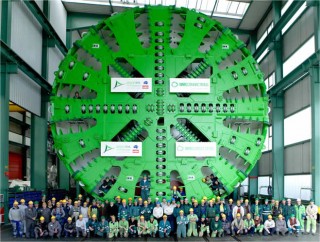 The first breakthrough of one of the two
12.45m diameter Herrenknecht EPBMs working on Brisbane’s 6.7km
long Airport Link project has occurred deep underground at
Wooloowin, marking the halfway point of the machine’s 2.5km
journey to Lutwyche. “Australia’s largest TBM,
Rocksy, has already excavated over 1,200m of tunnel since she
was launched at Kalinga Park in July,” announced Minister for
Infrastructure and Planning Stirling
Hinchliffe. “Considering that this time last year
pieces of the machine were being shipped to Brisbane from
Germany, this shows great progress on the
project.” Minister Hinchliffe congratulated
Rocksy’s tunnelling team who have worked tirelessly towards
today’s successful breakthrough. “Working around
the clock, seven days a week, the TBMs have progressed at
rates of up to 110m a week, digging the tunnels and lining
them with concrete segments as they go,” Mr Hinchliffe
said. “Across the project, over 9km of tunnels
have been completed, with the TBMs Rocksy and Sandy alone
having excavated more than 2.2km. “ Over
300,000 cubic metres of spoil has been generated by the TBMs
and transported to Nudgee Road via a 2km spoil conveyor,
eliminating almost 40,000 spoil truck movements from local
streets in Clayfield. “This is a terrific outcome
for locals and commuters using those roads.” ... Thiess
John Holland Project Director Gordon Ralph said the second
TBM, Sandy, was expected to break through into the Kedron
caverns next month, with both TBMs scheduled to complete their
2.5km journey by the middle of the year. “Once
tunnelling is complete the cutterheads for the massive TBMs
will be buried underneath the tunnels they have created,” Mr
Ralph said.
“The two TBMs were custom built for
the Airport Link project and this solution will reduce the
complexity involved in removing the cutterheads, while
avoiding the need for additional surface work in the Lutwyche
area.” BrisConnections CEO Dr Ray Wilson said
today’s breakthrough brought the team one step closer to the
operation of Airport Link in mid-2012. “More than
70% of the project is now complete and when Airport Link opens
in mid-2012, it will be the first major motorway connecting
Brisbane city with the airport and northern suburbs,” he
said. ”It will improve travel times, providing six
new lanes for drivers between Bowen Hills and Kedron and four
new lanes between Kedron and Toombul.” | - - -
http://suppliersandequipment.mining.com/2008/06/17/giant-gaskets-seal-underground-highway-tunnel/Giant
gaskets seal underground highway tunnel Written by
InfoMine - Mining Equipment and Supplier News, June 17th,
2008 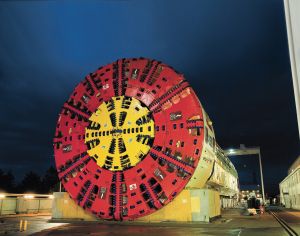 In Madrid, Spain, an underground highway
tunnel In Madrid, Spain, an underground highway
tunnel will help reduce traffic congestion. Like moles,
two massive tunnel boring machines have inched their way
forward, leaving a walled tunnel behind. Gaskets from
Trelleborg provide a waterproof seal between the massive
tunnel ring segments. ... One of the many solutions in
the project was a 3,650- meter highway tunnel that crosses the
city center underground, less than 6.5 meters away from a busy
subway line at certain points. Finished in mid-2007, the M30
“Bypass South-East” has three lanes in each tunnel and
sidewalks on each side. At the time of its construction, the
excavated dimensions of the tunnel, 15.2 meters in diameter,
were the largest ever required. This demanded an entirely new
breed and size of tunnel boring machine, also called a TBM or
“a mole.” “Two machines were used, one at each
end of the tunnel. TBMs are usually custom-made for each
individual tunnel project,” says Erwin Brakenhoff, Sales
Director, Trelleborg
Bakker in the Netherlands. “Costing in the millions
of dollars, a TBM has the advantage over other methods in
terms of safety and timing; in addition, it is extremely
precise, which in turn, reduces the cost of lining the tunnel.
This makes TBMs more suitable for use in built-up
areas.” Alfredo Avello, Director of Abyo, a
supplier of tunneling equipment in Spain, calls the M30 tunnel
project a team success. “This project was led by Madrid
Municipality, and two joint ventures formed by leading Spanish
contractors excavated the tunnels. In addition, other highly
qualified Spanish contractors executed very important
complementary surface works,” says Avello. “It has also been a
pleasure to work with Trelleborg, which supplied gaskets for
sealing the segments in both tunnels.” 
|
|
| | |
| TahoeBlue
|
http://www.hardenedstructuresofamerica.com/about.html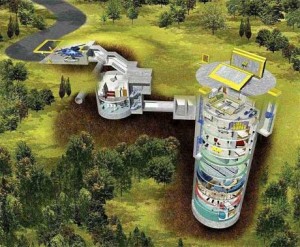 Hardened Structures of America Hardened Structures of America is a
Professional Construction Program Management Company, partners
of Hardened Structures and Hardened Shelters, LLC,
specializing in the confidential planning, design and covert
construction of fortified homes, bomb shelters, underground
shelters, homes with underground bunkers, survival shelters,
2012 Shelters, bu nkers and hardened military
facilities. These facilities are designed for
sustainability with independent sources of power and water and
incorporate numerous defensive and offensive capabilities.
They can serve as a primary dwelling, vacation home, corporate
retreat, long term shelter or expanded multi-function
compound. Client confidentiality and total project secrecy are
paramount on all of our projects. Hardened
Structures of America can provide all designs, planning,
estimating, engineering, modeling, construction and technical
support to offer complete turn-key survival facility solutions
for private/residential, commercial, military and special
projects. Hardened Structures can also provide all of the
specialized equipment necessary for underground bunker
construction, CBRE air filtering systems, blast doors, blast
valves, water generators, etc. http://englishrussia.com/2010/10/09/bunker-42-in-taganka/Bunker-42
- Taganka 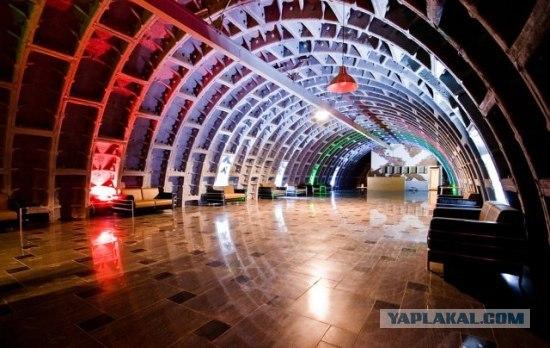 The Cold War Museum (exhibition complex
Bunker-42) is a military historical museum and an entertaining
complex founded in t he former classified military object of
the USSR – Alternate Command Center of Long-Range Aviation
(GO-42). The territory of the museum represents an
underground bunker with an area 7000 m2 located 60 m deep
near Taganskaya metro station. The museum has been working
since 2006 after Bunker-42 was bought from “Rosimuschestvo”
at the auction by “Novik Service” company. 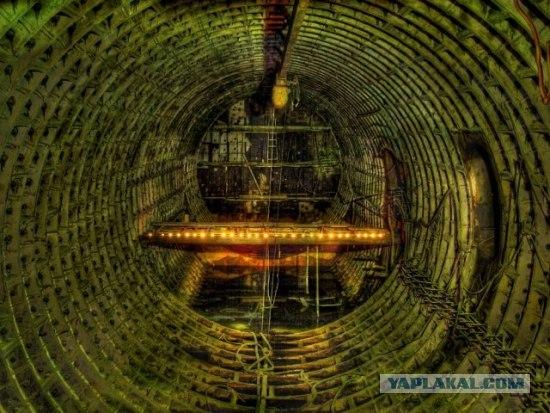 In the 1960s the object was equipped
with everything necessary in the case of nuclear attack. In the 1960s the object was equipped
with everything necessary in the case of nuclear attack.
Later, in the middle of the 70s, there was made up a decision
about its reconstruction. In 1995 the object was totally
declassified. In 2006 “Novik-Service” purchased the object for
2,166,700 USD and started its restoration. Only massive
armoured doors and steel sheathing of the walls remind about
the former classified object. More:http://picturesofmoscow.com/tag/sport/In
2006, the secret signal office centre, located at a depth of
60 meters and has an area 7000 square meters has been sold to
a private company. Now Soviet history is open to
visitors. The Red Bull company has spent today in
the bunker selection round of the World championship of
football freestyle.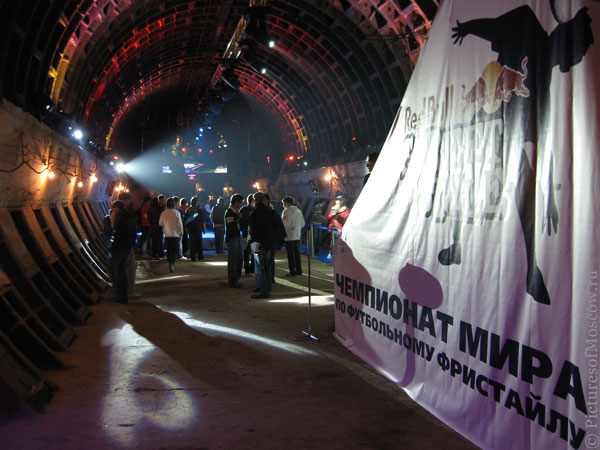 ... video's Top secret bunker
«Tagansky» 
|
|
| | |
| TahoeBlue
|
http://www.hcn.org/issues/42.10/a-boring-diagram June 07, 2010 issueby Sarah Gilman
Lake Mead -- Las Vegas' primary water supply -- has
been drawing down like a leaky tub over the past decade,
thanks to prolonged drought in the Colorado River Basin. The
reservoir's now at 43 percent of capacity and about 100 feet
below full -- just 45 feet above one of two main water
intakes. If projections pan out, the water level could drop
below that intake's pumping system by 2013. So the Southern
Nevada Water Authority plans to spend the next three years and
a total of $610 million digging under and up through the
reservoir's bottom with a
custom tunnel boring machine to build a new water
intake, 190 feet below the one that must be replaced, and
connect it to the existing water system. http://arizonageology.blogspot.com/2011/09/tunneling-under-lake-mead.html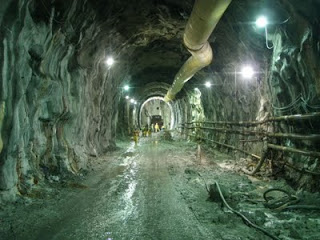 Monday, September 05, 2011 Tunneling
under Lake Mead Las Vegas is digging a 1,500
foot long tunnel, 600 feet below ground through bedrock to
suck water from Lake Mead, in case the lake level drops
too low for the existing intake to draw water. "Intake No. 3
will maintain SNWA's ability to draw upon Colorado River water
at lake elevations as low as 1,000 feet above sea level,
assuring system capacity if lake levels fell low enough to put
Intake No. 1 out of service." [right, Intake 3 tunnel. Credit,
SNWA] The starter tunnel is complete, ready for the
boring machine to be lowered into it for assembly. An earlier
starter tunnel was abandoned after it hit a fault zone and
unstable rock. SNWA has a short video explaining the
project. http://www.snwa.com/apps/video/index.cfml?cid=36&vid=139http://constructionnew.blogspot.com/2011_10_01_archive.htmlSaturday,
October 29, 2011 Herrenknecht TBM Gets Ready To
Drill Under Lake Mead 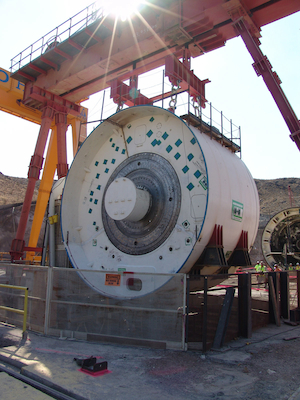 ... Southern Nevada's newest piece
of mega-hardware—a custom $25-million Herrenknecht
tunneling-boring machine—will make its long-awaited
underground debut later this year. The machine works
like a giant mechanical earthworm, gnawing through dirt, rock
and muck while forming a protective tunnel that will
eventually channel raw Colorado River water onto nearby
treatment plants before the water is pumped to homes and
businesses throughout the Las Vegas valley. The
1,800-ton, 600-ft-long TBM is the workhorse of a
$526.6-million third raw-water intake tunnel project at Lake
Mead, 30 miles southeast of Las Vegas. A joint venture of S.A.
Healy Co., Lombard, Ill., and Impreglio S.p.A., Sesto San
Giovanni, Italy, known as Vegas Tunnel Constructors (VTC) LLC,
is the design-build contractor. The additional intake is
needed because the lake has dipped 100 feet since 2000 amid a
decade of drought and boom growth. The TBM will
carve out a three-mile-long, 20-ft-dia reinforced tunnel under
Lake Mead that draws water at 860 feet. That depth is
deeper than the other two intakes, which may soon become
inoperable if water levels continue to fall. The drill
head, which rotates in 16 different positions, is already
underground. The five-piece TBM should be fully assembled by
early December, with commissioning to follow.It
has been a long, hard road to reach this point.
Herrenknecht’s Schwanau factory in southern
Germany took 17 months to design and manufacture the
machine, which was shipped in five large pieces to
California’s Long Beach Harbor and then transported to the
jobsite outside of Boulder City, Nev., in 61 truckloads. The
transportation feat took months of planning and coordination,
mapping out the route and securing special heavy-haul permits.
In 2010, an intake starter tunnel flooded
three times in six months, prompting the construction team to
abandon its original alignment and drill in a drier direction,
roughly 23° northeast from the problematic tunnel along a ½°
uphill slope. The move increased project costs by 15% and
pushed the completion date back two years, to 2014. As
it stands, the TBM is being lowered piecemeal down a
30-ft-dia, 600-ft-deep access tunnel using a head-frame-gantry
system with dual 200-ton strand jacks. It took crews 32 hours
to lower the 315-ton drill head. "There
was only three to four inches clearance on either side,"
explains Jim Nickerson, VTC deputy project
manager. 
|
|
| | |
| TahoeBlue
|
http://www.herrenknecht.de/http://www.herrenknecht.de/produkte/tunnelvortriebsmaschinen/traffic-tunnelling/mixschild.html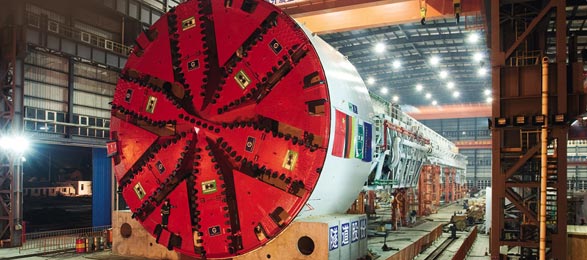 http://www.waterworld.com/index/display/article-display/340838/articles/waterworld/projects-contracts/herrenknecht-tunnel-boring-machines-reach-targets-in-shanghai.html http://www.waterworld.com/index/display/article-display/340838/articles/waterworld/projects-contracts/herrenknecht-tunnel-boring-machines-reach-targets-in-shanghai.html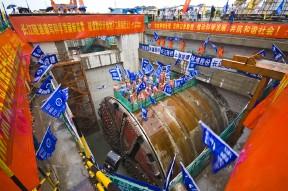 SHANGHAI, China, Sept. 19, 2008 -- Two
Herrenknecht tunnel boring machines, the largest in the world
with a diameter of 15.43 meters, successfully completed their
crossing beneath the Yangtze River in Shanghai. SHANGHAI, China, Sept. 19, 2008 -- Two
Herrenknecht tunnel boring machines, the largest in the world
with a diameter of 15.43 meters, successfully completed their
crossing beneath the Yangtze River in Shanghai. On May 28
and September 5, 2008, the two Mixshields met their target
shafts precisely on the Yangtze River island Changxiang -- far
ahead of schedule. The 7,472 meter long tunnels connecting the
Shanghai district of Pudong with Changxiang island have
created efficient transport systems in only 20
months. The Herrenknecht Mixshield S-318, one of
the two largest tunnel boring machines (TBM) in the world with
a diameter of 15.43 meters, reached its target shaft on the
Yangtze river island Changxiang on September 5, 2008. But not
only this giant showed a top performance, excavating an almost
7.5 kilometer long tunnel tube in highly water-bearing
construction ground in only 20 months. A good three months
before, on May 28, 2008, the identical Herrenknecht Mixshield
S-317 reached its target shaft with great precision. Using the
two high-tech giants from Schwanau, the shell of the two
parallel running large diameter tunnels, which are scheduled
to be opened for car and subway traffic for the 2010 World
Exhibition, could be completed 10 and 12 months ahead of
schedule respectively. Shanghai,
China In May and September 2008 the two world
largest tunnel drilling machines - two gentleman farmhand
mix sign with 15.43 meters of diameters - locked the
propulsion under Jangtse river successfully in Shanghai. After
20 months 7.5 kilometers of combined road and Metrotunnel were
finished in the carcass. One year in former times than planned
reached the giants their goal on the Fluss-Insel Changxing.
Thus the chances stand well that the two parallel tunnel tubes
can be transferred to traffic punctually to the world fair
2010 in Shanghai. http://www.herrenknecht.com/fileadmin/redaktion/PDF_Downloads/S-317_S-318_Shanghai_Folder_GB_09-03-11.pdfNEW
MILESTONE: BIG SUCCESS IN SHANGHAI. THE WORLD’S LARGEST
TUNNEL BORING MACHINES CROSSED BENEATH THE YANGTZE
RIVER. The largest Tunnel Boring Machines worldwide.
Herrenknecht provided two 15.43 meter diameter Mixshields to
excavate two 7.47 kilometer-long parallel tunnels, which cross
beneath China’s largest river, the Yangtze. The Yangtze River
is one of the country’s busiest waterways. To avoid
impediments to vessel traffic, mechanized tunnelling was
preferred over an immersed tunnel or bridge construction in
the very busy south channel of the Yangtze River. The twin
tunnels are located at a depth of up to 65 meters in
groundwater-bearing sand, clay and broken rock formations. The
multi-functional tunnels will have two levels: the upper deck
will be used as 3-lane road tunnel. The lower deck will serve
as service and rescue tunnel. The longterm objective is to
also use the lower deck for metro traffic by integrating the
Shanghai Rail Transit Line 9. Dongtan – the first
planned eco-city. The world’s first eco-city is to be
created in the middle of the Yangtze River delta. This pilot
project for Chinese environmental policy will be realized on
the island of Chongming off Shanghai in the coming years. The
planned eco- city will be built according to the strictest
environmental standards. Dongtan will have the most up-to-date
environmentally-friendly technology. From waste recycling
and water treatment – still far from standard in China to
supplying heating and electricity from renewable energy
sources. However, the planners are going a couple of steps
further; they want to restrict car traffic to the periphery of
the residential areas, which is why their transport planning
is oriented towards pedestrians and cyclists. They plan to
locate working and living close enough to each other to make
energy-consuming commuter traffic unnecessary. The
residential blocks are planned with no more than 8 stories,
including their greened rooftops. The ambitious plan of the
British engineering studio Arup and the Shanghai Development
Company SIIC is to complete the initial phase in time for the
World Expo 2010. Some 80,000 people from various social
backgrounds are expected to live in Dongtan by the year
http://www.herrenknecht.com/news/press-section/none-bigger-tunnel-boring-machine-for-orlovski-tunnel-brings-new-world-record.htmlNONE
BIGGER: TUNNEL BORING MACHINE FOR ORLOVSKI TUNNEL BRINGS NEW
WORLD RECORD. 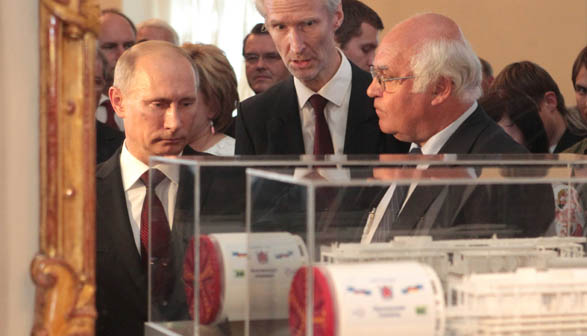 In early July 2011, the Russian operator
company NCC (Nevskaya Concession Company) placed an order with
Herrenknecht – the TBM manufacturer, based in Schwanau,
Germany – for the construction of a Mixshield. The tunnel
boring machine (TBM) for the Orlovski Tunnel will surpass all
previous TBMs. With a diameter of 19.25 m, the tunnelling
shield, designed to link both halves of the center of St.
Petersburg under the River Neva, sets a new world
record. St. Petersburg,
Russia / Schwanau, Germany, 17 August 2011. On the occasion of
the contract signing for the world’s largest tunnel boring
machine, entrepreneur Martin Herrenknecht recently met the
Russian Prime Minister, Vladimir Putin, in St. Petersburg. In
a high-level business meeting, Mr. Putin wanted to find out at
firsthand about the gigantic automobile tunnel project – an
extremely challenging construction project under the River
Neva, which will be carried out using the world’s biggest
tunnel boring machine. The contract for the
manufacture of a 19.25 m diameter Mixshield, which smashes all
previous diameter records, had previously been signed by
the Russian operator company, NCC (Nevskaya Concession
Company) and Herrenknecht AG. For Herrenknecht, this is the
biggest single order in the company’s history and represents a
huge technical challenge, which has been well prepared by
extremely thorough, intensive preparatory engineering
collaboration between the customer and the
contractor. Including the backup, the
Herrenknecht Mixshield will be a total of 82 meters long. On
its own, the tunnelling shield will weigh around 3,800 tons
and deliver 8,400 kW drive power to the cutting wheel. The
leap in diameter to 19.25 m will enable the machine to
excavate 600 cubic meters of soil hourly. The excavation
area is more than 50% larger than that for the largest TBM
currently in operation in the world (see list of record
holders below). A Mixshield is the quickest and safest
solution for driving the around 1 km long tunnel bore under
the Neva in the face of the high groundwater pressures. An
extremely ambitious timetable has been set for implementation
of the project. Tunnelling is set to begin in St.
Petersburg in the spring of 2013, with the tunnel due to be
taken into operation in 2016. The aim of this new
and world’s largest mechanically bored tunnel is to provide
significant relief in the center of St. Petersburg and allow a
continuous traffic flow in the city divided by the
river. http://www.cowi.com/menu/NewsandMedia/News/BridgeTunnelandMarineStructures/Pages/st-petersburg-to-build-worlds-widest-bored-tunnel.aspxSt
Petersburg to build world’s widest bored tunnel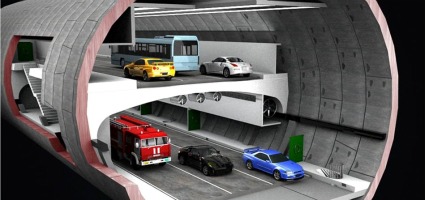 
|
|
| | |
| TahoeBlue
|
http://www.popsci.com/category/tags/tunnel-boring-machine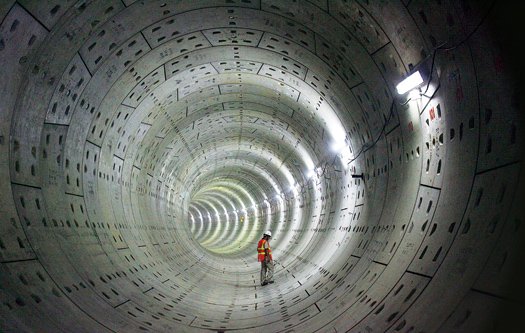 A Race Against Time To Complete New
Delhi's Newest Subway Line A Race Against Time To Complete New
Delhi's Newest Subway Line By Sandeep Ravindran Posted
02.10.2010 at 11:23 am A worker stands inside one
of the Metro tunnels under construction in New Delhi, India,
in preparation for the Commonwealth Games this October. To
overcome the challenges of a tight three-and-a-half-year
schedule and construction underneath a densely populated city,
engineers used 14 tunnel-boring machines (TBMs) to dig the
underground thoroughfarehttp://www.thehindu.com/news/cities/chennai/article2731213.eceTunnelling
will throw up debris, and challenges too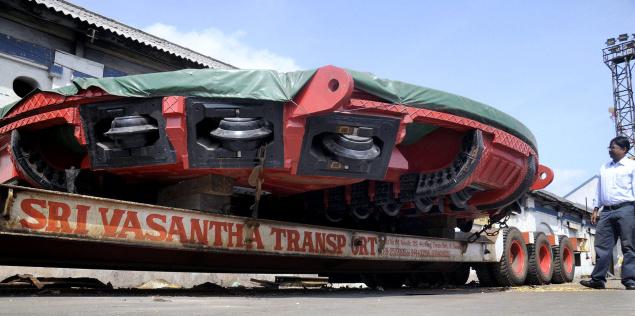 With the city receiving its first batch of
Tunnel Boring Machines that will be used to build the Metro
Rail network's underground section, it is only a matter of
time before massive subterranean holes begin to take shape
beneath the surface. ... But much of the ‘pain' would be
due to underground station construction. Tunnelling, on the
other hand, would have little or no impact at the surface
level. Chennai Metro Rail Limited Managing Director
K.Rajaraman says that people will not even know that holes are
being drilled beneath the surface. Out of the 11
TBMs that would eventually be in operation, the first one
would be launched from Washermenpet. The tunnelling
would be controlled by precision electronic systems. The
cutting rotor (shield) of each TBM would also be supported by
a 78 metre long trailing assembly, consisting of components
that provide mechanical support and help remove the excavated
material. To put it simplistically, the TBM works
similar to an earthworm with cycles of digging forward and
dragging the rear end afterwards. A series of hydraulic
systems push the TBM forward (excavating the soil), while the
rear end of it is braced against the tunnel wall. When the TBM
head has excavated to its maximum length, the ‘shield' and the
rear end is pulled forward 
|
|
| | |
| TahoeBlue
|
http://www.groundwateruk.org/Groundwater-Issues-Radioactive-Waste-Disposal.aspx One of the experimental galleries at a
depth of 420m in SKB’s underground research laboratory
at Aspo, Sweden. Rob Cuss © NERC 2008  Tunnel boring machine driven incline
from the 420m to 440m levels in SKB’s underground
research laboratory at Aspo, Swede Tunnel boring machine driven incline
from the 420m to 440m levels in SKB’s underground
research laboratory at Aspo, Sweden. The laboratory
is constructed in granodiorite. Rob Cuss © NERC
2008  Driving a new experimental gallery at a
depth of 490m in the Bure underground
research
laboratory in the eastern Paris Basin, France. John Powell
© NERC 2009 Deep geological radioactive waste
disposal in other European Countries While
progress towards a solution for the long-term management of
the United Kingdom’s radioactive waste has been progressing
over the last 8 years, internationally some projects are now
at an advanced stage. In Europe, Finland is
developing an underground characterisation facility at
Olkiluoto, known as the ONKALO, which has now reached a
depth of about 320m. If ONKALO confirms that the site meets
all the safety case criteria for the development of a
repository, a facility will be developed at the site with a
planned commencement of disposal operations around 2020.
Sweden has evaluated two potential sites for the
disposal of spent fuel, one near Forsmark and the other near
Oskarshamn, and in June 2009 announced that their
preferred site for the development of a repository was that at
Forsmark. They also have constructed and operate the Äspö
underground hard rock laboratory, near Oskarshamn, that is
used for full scale in-situ testing of different
technical solutions in a realistic repository environment and
have operated an ILW disposal facility at Forsmark for
20 years. Both Belgium and France have underground
research laboratories and are close to deciding where
their disposal facilities will be located. All of these
countries have worked in partnership with the local
communities and have a high level of support from them for
their projects. 
|
|
| | |
| TahoeBlue
|
http://www.frieze.com/issue/article/tunnel_vision_pendle/Tunnel
Vision Informant A new exhibition about New York’s
underground earth works reveals a quasi-mythological mirror
image of the city 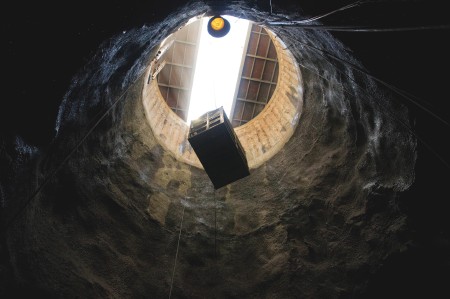 Workers are lowered into the Tunnel
Boring Machine Launch Area, 26th Street and 11th Avenue, New
York (2008... . ‘The Future Beneath Us’,
currently on show at the New York Transit Museum Gallery
Annex, and at the Science, Business and Industry Library,
speaks of a mirror city to New York, a benighted, unglamorous
metropolis of dark shafts and damp thoroughfares in which air
is hewn out of rock, rather than rock heaped into air. It
paints this portrait quite accidentally while describing the
eight massive subterranean construction projects currently
taking place deep beneath the city’s surface. The
simultaneous creation of a thicket of tunnels, hubs and work
plants has seemingly resulted in an alter-city being formed, a
sunless empire hidden entirely from the view of most of the
city’s denizens. Chief among the projects is the
gargantuan Water Tunnel No. 3, one of the largest engineering
projects in the world. It has a diameter of seven
metres, stretches for almost 100 kilometres, and reaches
depths beneath the city of over 250 metres, as deep as the
Chrysler building is high. It is a work of monumental size and
beauty, a gargantuan concrete tube laid down amidst a
glistening backdrop of quartzofeldspathically-banded
garnetiferous muscovite-biotite schist. The only shame is that
it will never be seen. Its entombment is part of its creation.
It is a true earth work. 
|
|
| | |
|
|
| TahoeBlue
|
http://www.pixpow.com/general/amazing-tunnel-machine/http://tunnellingjournal.com/news/855/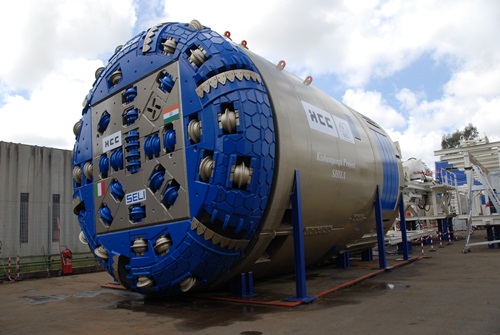 Italian tunnelling specialist SELI has
celebrated its 60th Anniversary Italian tunnelling specialist SELI has
celebrated its 60th Anniversary by manufacturing a
400-ton, 6.18m diameter DSU TBM painted gold, for the
Kishanganga tunnel project in India. The gilded machine
was delivered to the main contractor HCC (Hindustan
Construction Company) today during an official ceremony at the
company’s factory in Aprilia. The DSU TBM will bore
700-1000m under the Himalayas, crossing critical geological
conditions of localised poor and squeezing rock as well of
fault zones. The TBM has been specially designed to cope
with the ground conditions and improve them through extensive
pre-treatment works. ... The company was founded by
Mr. Carlo Grandori in 1950, and it was he who introduced
mechanised TBM excavation technology to Italy in 1969 and,
alongside Mr. Dick Robbins, designed and manufactured
the first Double Shield TBM. SELI claims to be
the only company in the world that acts as TBM manufacturer
and TBM tunnelling contractor, with experience of 800km of
tunnels in over 100 projects all around the
world. The new SELI factory under completion
in Aprilia (Rome) will boost the TBM production capacity from
today’s 8 units per year to over 20 units, with boring
diameters exceeding 15m diameter. http://secondavenuesagas.com/2010/05/14/down-the-rabbit-hole-a-tunnel-boring-machine-comes-alive/Down
the rabbit hole, a tunnel boring machine comes
alive By Benjamin Kabak 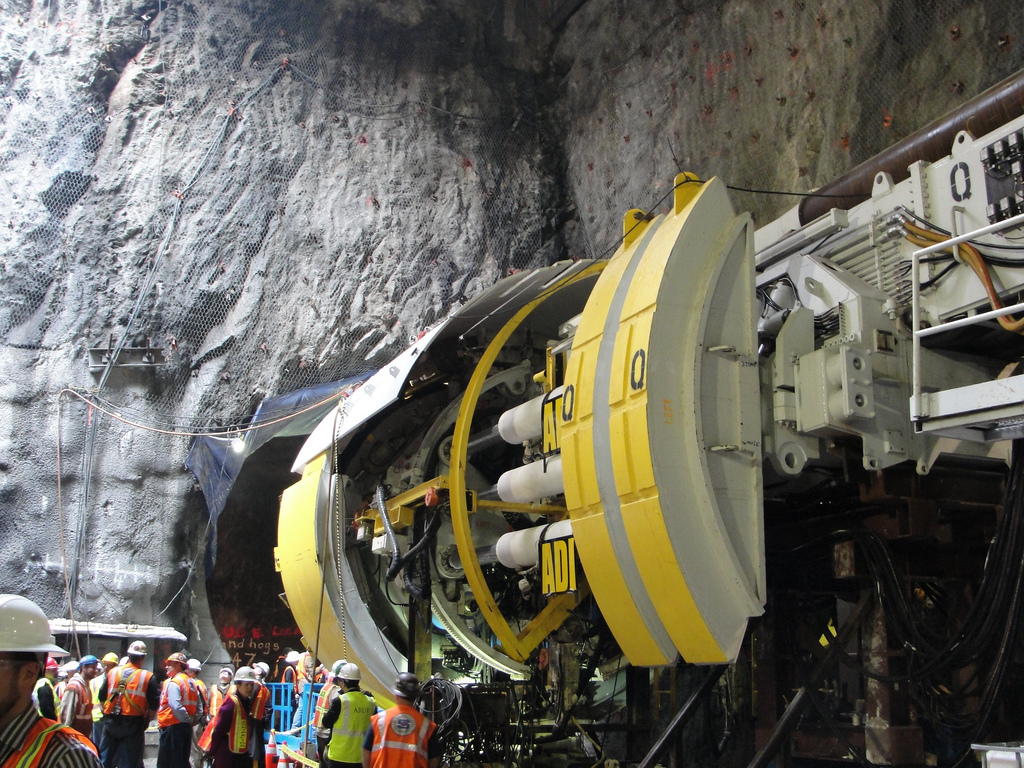 For the first time since the April 2007
groundbreaking, the MTA invited reporters and city officials
underground to mark another Second Ave. Subway
milestone. Today, at shortly after 10:30 a.m., MTA CEO and
Chairman Jay Walder blasted an air horn that marked the
start of the tunnel boring machine’s journey from 92nd St. to
63rd St. With two City Council members and a House
representative along for the photo op, the MTA reaffirmed its
commitment to Phase 1 of the Second Ave. Subway and stressed
the December 2016 completion date. 
|
|
| | |
| TahoeBlue
|
http://www.blippitt.com/gotthard-base-tunnel-ahead-of-schedule-photos/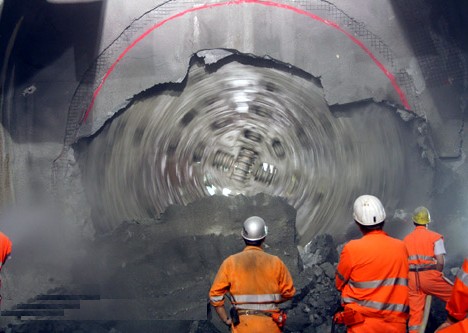 Gotthard Base Tunnel Ahead of Schedule
(PHOTOS) Sept 2009The Gotthard Base Tunnel now
being drilled out beneath the Alps Gotthard Base Tunnel Ahead of Schedule
(PHOTOS) Sept 2009The Gotthard Base Tunnel now
being drilled out beneath the Alps, the
longest underground tunnel ever constructed, came
one step closer to completion earlier this month when another
two sections were connected. Tunnel boring
engineers broke through the last several feet of rock between
Erstfeld and Amsteg near the northern end ... http://www.blippitt.com/gotthard-base-tunnel-another-breakthrough/The
main section of the Gotthard Base Tunnel is 34 miles long
and connects northern and southern Europe, said
AlpTransit Gotthard company in a prepared
statement. The world’s longest tunnel should become
operational at the end of 2017,” the statement
said. The company says the tunnel is an
environmental feat and will allow millions more tons of
items to pass through the Alps by rail. “Only
by upgrading its railway infrastructure can Switzerland meet
the rising demand for freight transportation and the
increasing needs of customers,” the statement
said. High-speed trains moving at speeds of up
to 155 mph will greatly shrink travel times between Zurich,
Switzerland and Milan, Italy. The tunnel
is currently scheduled to open in 2017. It will be a total
of about 95 miles long when completed. http://www.vectorsite.net/g2007m08.html... Surprisingly,
problems arise not because the rock is too hard but because
it is, in places, too soft, like butter, complicating the
digging and slowing it to a crawl. The problems have caused
the price tag to almost double, and the tunnel is not expected
to be finished before 2018. 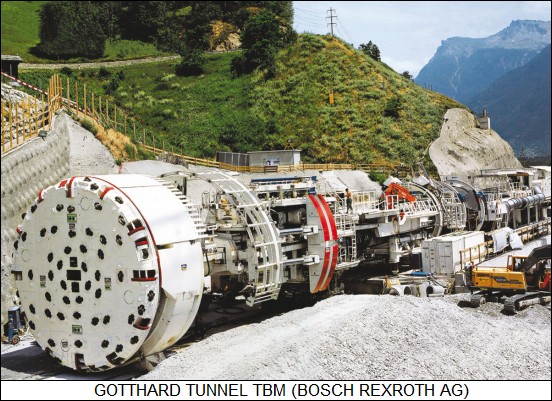 * In related news, an article on BBC WORLD
Online ("Africa & Europe Set For Tunnel Link" by Richard
Hamilton) says the governments of Spain and Morocco are now
in discussion towards plans to put a railway tunnel beneath
the Straits of Gibraltar. 
|
|
| | |
| TahoeBlue
|
http://www.tunneltalk.com/Dick-Robbins-Mar09-Franklin-Medal-winner.php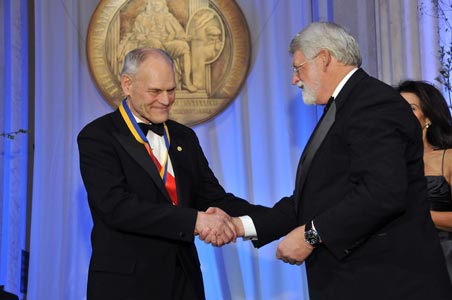 Dick Robbins receiving his
award Dick Robbins receiving his
award... Richard J. Robbins, President and
CEO of The Robbins Company from 1958 to 1993 is to receive the
prestigious Benjamin Franklin Medal for Engineering. Dick
is being honored for his career dedication to the development
of tunnel boring machine technology and the application of
TBMs for some of the largest and most challenging tunneling
projects in history. Dick joins an illustrious list of
previous recipients including, Albert Einstein, Thomas Edison,
Stephen Hawking, and Jane Goodall. http://www2.fi.edu/press/images-and-media/awards/2009/bios/09/robbins.pdfRichard
J. Robbins President The Robbins Group, LLC Seattle,
Washington The 2009 Benjamin Franklin Medal in
Engineering is presented to Richard Robbins for
his
imagination and skill in developing a hard-rock tunnel
boring machine and its associated
systems, resulting in a
safe, economical, and efficient method for constructing
tunnels.From man’s first invention of gun powder,
explosives were used to blast through rock and ground to
make tunnels. This dangerous process, used to build new roads
or mines, remained largely-unchanged until the 1950s
when Dick Robbins helped bring an entirely different kind
of
rock-cutter to the world’s attention – enabling for the
first time such massive projects as digging
a tunnel under
the English Channel. Through the family tunnel drilling
company, Robbins
produced Tunnel Boring Machines [TBM]
that could economically, efficiently, and safely
bore
through not only hard rock, but also through changing
terrain or terrain pressurized with water.While he had
competitors, it was Robbins who provided the first truly
viable TBMs, ushering in an era of rapid,
cost-effective, and safe tunnel construction. Robbins
earned his B.S. in mechanical engineering from Michigan
Technological University in 1956. Just two years after he
graduated, he took over the family’s tunneling company upon
the untimely death of his father. In addition to the
difficulty of trying to keep the company running, Robbins
focused on refining his father’s ideas for a new rock boring
machine. He substituted hard disks for the drill bits that
kept breaking; he added hydraulic pistons to increase the
pressure and help fragment the rock; he developed ways to
remove the rock without having to stop drilling; and he
ultimately even added maintenance shops and crews’ quarters to
the giant machines. He gained a reputation in the drilling
community for providing machines that could tackle the most
difficult projects, safely and inexpensively, and for being
someone who could constantly dream up new improvements and
then actually build them. ... http://www.convertingtoday.co.uk/story.asp?storycode=13042Carlo
Grandori October 2002 By Dick Robbins, friend
and collaboratorThe international tunnelling
community has lost one of its most innovative and productive
personalities. Carlo Grandori, founder of Societa Esecuzione
Lavori Idraulici (SELI), died on 17 September at the age of
91. I was privileged to attend the service in Rome where many
of his friends and colleagues gathered to remember his
life.Carlo Grandori was a industrial engineer
who specialised in hydroelectric construction and large dams.
After World War ll, he concentrated on the tunnelling and
underground aspects of this specialty and became known as an
expert in traditional rock tunnelling. In the early 1960s
he participated as a joint venture partner in machine
tunnelling projects with his friend and TBM pioneer, Duri
Prader, in Zurich, Switzerland. I first met Carlo
when he visited Seattle in 1967. He was planning a bid for the
Orange-Fish project (T&TI, May 1969) in South Africa and
was considering the possible application of a tunnelling
machine. Although a machine was not chosen for this project,
Carlo and his engineers continued to look for a machine
tunnelling job they could sponsor. After a complicated
negotiation with ENEL, SELI was awarded the 4.5km
Brasimone-Suviana Tunnel near Bologna, Italy, in about 1970.
The rock in the 6.4m diameter tunnel was unstable and
complicated and required immediate support. Carlo initiated
the design of interspersing steel ribs with precast segments
as close as possible to the front of the tunnelling machine.
This started a trend in Europe of using precast segments in
rock tunnels that would eventually extend to many other parts
of the world. The unstable rock face led Carlo to suggest
modifications to the cutterhead, which was the first attempt
at rotary breasting or active support of the face while
boring. It was clear to Carlo Grandori that tunnel
boring machines were in the early stages of development for
bad rock conditions. In-the-tunnel modifications would be
required to adapt the machines to the rock, as it became
apparent how the rock was reacting to the tunnel opening being
bored. This initiated a life long collaboration for me with
Carlo and his team. In 1972 I brought to Carlo the
idea of a telescoping shield machine with grippers located in
the aft shield so that segments could be set while the boring
was in progress. Carlo was intrigued and immediately began
to sketch improvements to the concept. He realised that
driving a machine through the rock was only one element of a
successful job. Erecting supports, advancing infrastructure
services and hauling out the muck were equally important
tasks. The activities supporting the machine advance provided
great potential for improving the efficiency of machine
tunnelling. In 1972 SELI secured the Orichella and
Timpagrande tunnels in Calabria, a 4km long, 4.3m diameter,
complex of tunnels in partly decomposed granite. This was to
be the first application of a double shield tunnelling
machine. Carlo Grandori spent many days in his tunnels
watching the machines and their trailing equipment perform. He
was an active innovator and as a result the SELI double shield
jobs performed with better results than could be achieved by
other contractors. After his son Remo had completed his
engineering studies and military commitments he joined the
SELI firm and gradually took on larger responsibilities in the
machine and tunnel engineering work. Carlo shifted his
concentration to unique designs of trailing or 'backup'
equipment and segment installation. Some years and many
double shield machines later, SELI collaborated with Prader on
the 7.5km long Langeten Relief Tunnel (1988-1991) in
Switzerland where a double shield machine installed hexagonal
segments for the first time. Carlo utilised this experience to
design the backup system for the Yindaruqin Irrigation
Project in China (T&TI, June 1991). This design
proved to be a major step forward. The machine, operating in
relatively favourable rock conditions, advanced 1,200m to
1,300m per month, while installing the hexagonal precast
segmental lining. This job led to a long series of successful
tunnel jobs in China. Carlo remained active in the
design of backup systems until quite recently. He designed a
system for the Manabi project in Ecuador, which was only
recently completed. The tunnel achieved an average advance of
64m per day. Carlo's technical contributions and
leadership in the field of tunnelling will be missed by the
entire industry. However, he was quite successful as a mentor
and teacher to many people who can carry forward his design
concepts and creative problem solving in
tunnelling. Carlo's health had deteriorated in recent
months, but he would recover to enjoy travel to the sea and
beach walks with his family. Son, Remo, continues
leadership of the SELI company which is currently working on
16 TBM tunnel projects, from hard rock to large EPB TBMs, on
five continents.http://www.herrenknecht.com/news/press-section/martin-herrenknecht-becomes-the-first-european-to-receive-the-moles-award-in-the-usa.htmlMARTIN
HERRENKNECHT BECOMES THE FIRST EUROPEAN TO RECEIVE THE “MOLES
AWARD” IN THE USA. 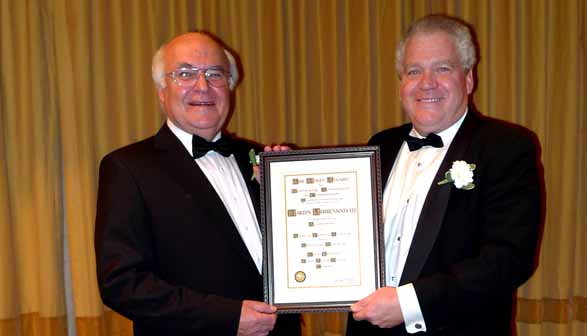 The renowned association of the US heavy
construction industry, “The Moles”, has presented the Schwanau
entrepreneur Dr. Martin Herrenknecht with the “Moles Award
2009”. This makes Martin Herrenknecht the first European and
non-US citizen to be honored with this prize. “The Moles”
award is highly regarded in the heavy construction industry in
the US. New York City, USA / Schwanau, Germany,
February 4, 2009. Dr. Martin Herrenknecht was presented with
the “Moles Award 2009” in New York on January 28, 2009, in
the presence of some 2,000 decision-makers and representatives
of the US heavy construction industry, as well as the
Governor of New Jersey, Jon S. Corzine. Martin
Herrenknecht is the first person living in Europe to receive
this award in the more than 70-year history of the Moles
Association. In addition, the Schwanau entrepreneur was
awarded honorary Moles membership. The Moles Association is
the most important association of decision-makers and
representatives of the US heavy construction industry on the
country’s east coast. The former US President Herbert C.
Hoover is also among those who have been honored with the
Moles Award in the past 
|
|
| | |
| TahoeBlue
|
Both Belgium and France have underground
research laboratories and are close to deciding where
their disposal facilities will be located. All of these
countries have worked in partnership with the local
communities and have a high level of support from them for
their projects. http://www.sckcen.be/en/Our-Research/Research-facilities/HADES-Underground-laboratoryHADES -
Underground laboratory The underground
laboratory HADES is the most important research infrastructure
in Belgium for experimental research on the deep geological
disposal of radioactive waste. In 1980, the
Belgian Nuclear Research Centre, SCK•CEN, started the
construction of the underground laboratory. HADES is
situated in Boom clay at a depth of 224 meters and was
extended in different phases: recently, the construction of a
second access shaft (1997-1999) and the building of the
connexion gallery (2001-2002) were completed 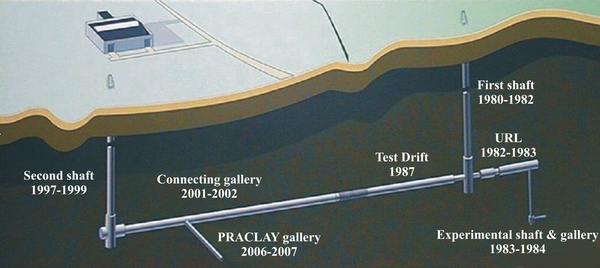 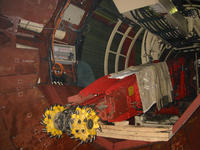 ... The Boom clay
formation The underground laboratory HADES is
situated in a Boom clay formation at a depth of about 224
meters. Within the Belgian research programme, the Boom
clay is studied as a reference formation for the geological
disposal of radioactive waste. However, the site where the
future disposal facility will be built has not been chosen
yet. The Boom clay is found on the site in Mol
at a depth between 161 and 264 meters. It reaches a total
thickness of more than 100 meters. Safety assessments
confirm that the Boom clay possesses good qualities, also
thanks to its low hydraulic conductivity and good sorption
properties regarding radioelements. Therefore, it is a
potentially interesting host rock for the disposal of
radioactive waste. 
|
|
| | |
| TahoeBlue
|
http://www.isrm2011.com/upload/shortcourse/WS5.pdfISRM12
th International Congress on Rock
MechanicsBeijing, China, October 16-21,
2011Networks of Underground Research
Laboratories for International, Inter-disciplinary
InnovationsSynopsis of Workshop Underground
Research Laboratories (URLs) were initially developed in the
1970s in Sweden for thermal and
hydrological responses to
emplacements of spent nuclear materials. Over a dozen URLs
have since been and
established and planned worldwide for
studying coupled
thermal-hydrological-mechanical-chemical-biological
processes.
Similar number of underground facilities has been
developed for physics research, mostly at great
depths
along roadway tunnels and in mine levels. There are
growing interests to use underground
laboratories
for energy and environmental studies and with emphasis in
multi-disciplinary and inter-disciplinary approaches.
This URL workshop will discuss if networking among
underground laboratories can be further developed from state
of knowledge gained from past experience, current status of
operation, and evolving plans. The preliminary agenda and
topics to be discussed are given in the following
table. http://articles.cnn.com/2010-11-12/world/finland.nuclear.waste_1_nuclear-waste-disposal-canisters?_s=PM:WORLD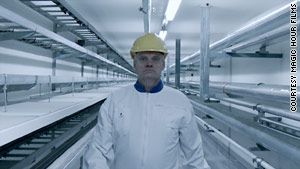 Finland's nuclear waste bunker built to last
100,000 years Finland's nuclear waste bunker built to last
100,000 yearsNovember 12, 2010|By Matt Ford for
CNN It's one of the great questions of our age: What to
do with nuclear waste? It's challenging, not just
because radioactive material is highly toxic, but because
really engaging with the problem forces us to confront
unimaginable timescales. But in Finland they
believe they have found a solution, with the world's first
permanent nuclear-waste repository -- "Onkalo" -- a huge
system of underground tunnels that is being hewn out of solid
rock and must last at least 100,000 years. "It is
our law that we have to dispose of our nuclear waste within
Finland's borders," Timo Seppala, from Posiva, the company
constructing the site, told CNN. 
|
|
| | |
| TahoeBlue
|
http://www.wadenelson.com/gasbuggy.htmlNuclear
explosion shook Farmingtonby Wade H.
Nelson There was no mushroom cloud, but on December
10, 1967, a nuclear bomb exploded less than sixty miles from
Farmington New Mexico. Today, all that remains at the site is
a plaque warning against excavation and perhaps a trace of
tritium in your milk. The explosion was part of
Operation Plowshare, a program conducted by the Atomic Energy
Commission (AEC) to explore peaceful uses of atomic bombs. AEC
scientists proposed using nuclear weapons as high-powered
dynamite in a variety of "nuclear landscaping" projects. The
most ambitious Plowshare proposal suggested setting off as
many as 300 hydrogen bombs to blast a newer, larger canal
across the Isthmus of Panama. The goal of the
Farmington blast, code-named Gasbuggy, was to see if a smaller
underground nuclear explosion would stimulate the release of
natural gas trapped in dense shale deposits. Gasbuggy
called for a 29 kiloton warhead to be set off four thousand
feet underground in an existing, low-productivity gas
well. Participants in Project Gasbuggy included the AEC,
the Bureau of Mines and the El Paso Natural Gas Company
(EPNG). Ground zero was seven and a quarter miles south on
Forest Road 537, south off State Highway 64, in the Carson
National Forest. ... Nation-wide, it was hoped
nuclear stimulation of gas wells might result in the recovery
of as much as ten times the amount of natural gas as was then
being recovered and help relieve the nation’s energy
crisis. The
Gasbuggy blast created an underground cavern approximately 160
feet in diameter by 333 feet tall --imagine putting
an oversized football field on a stick like a popsicle,
pushing it 3800 feet down into solid rock, and twirling it. A
few seconds after the explosion the molten glass-lined cavern
collapsed, creating a chimney filled with rubble and debris.
Geologists later estimated that fractures extended out from
the cavern a few hundred feet in all directions. http://en.wikipedia.org/wiki/Operation_PlowshareProject
Plowshare was the overall United States term for the
development of techniques to use nuclear explosives for
peaceful construction purposes... Other proposals
involved blasting underground caverns for water, natural
gas, and petroleum storage. Serious consideration was also
given to using these explosives for various mining
operations. One proposal suggested using nuclear blasts to
connect underground aquifers in Arizona. Another plan involved
surface blasting on the western slope of California's
Sacramento Valley for a water transport project 
|
|
| | |
| TahoeBlue
|
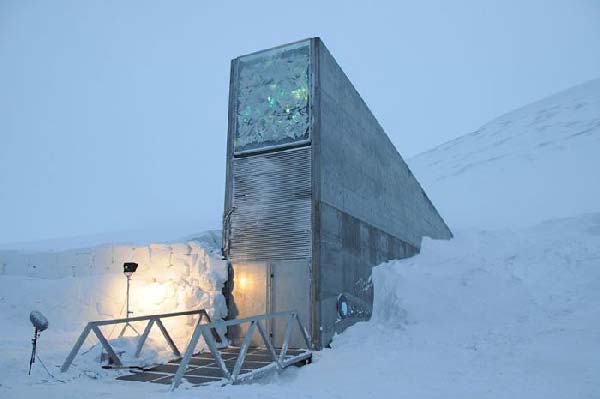
Norway Doomsday seed vault bunker
videohttp://blog.2012pro.com/2012/2012-underground-survival-bunkers-%E2%80%93-norwegian-politician-speaks-about-surviving-global-catastrophe-in-the-government-bunkers-in-norwayThe
person who wrote this message to us did so under their own
name (which we have checked), and enclosed a number of
photographs of them with the Prime Minister of Norway and
(separately) with Benazir Bhutto. We are certain of their
bona fides, but you will understand that we cannot reveal
their real name or publish any photos without consent.
The
content of this message, if true, could hardly be more
important.... All the sectors and arks are
connected with tunnels and have railcars that can take you
from one ark to the other. This is so that they can be in
contact with each other. Only the large doors separate them so
that the sectors are not compromised in any matter. http://www.ngi.no/en/NGI
worldwide - NGI is an internationally actor within our
fields of expertise. Approximately 30 per cent of NGIs work
is on projects outside Norway.NGI Inc., NGI's
daughter company in Houston, Texas, contributes to
enhanced contact with the international oil and gas
industry Our services are applicable for almost all
facets of civil engineering. Examples are foundations for
buildings and large structures such as bridges, railways and
road building, water supply and sewage systems, tunnels and
rock caverns, coastal engineering and embankments and
rockfill dams. We cover the whole planning process from
feasibility and impact studies to detailed design and
follow-up at the construction
site. State-of-the-art NGI did the foundation
engineering for the new Oslo Opera and for the neighbouring
immersed tunnel crossing in Bjørvika. The innovative
tunnel was constructed by elements floated into position and
lowered onto a pre-made channel on the seabed, and then
assembled. Our
knowledge has been used to develop the Q-method - a tool which
is used internationally to classify rock masses and assess
permanent rock support in tunnels and caverns.
Since its introduction in 1974, the Q-method has been updated
several times. This empirical method is based on data from
existing tunnels around the world. Our expertise also includes
numerical modelling and recommendation of stabilizing
measures. NGI has a world-class geo-laboratory, with
experienced personnel. http://thelistcafe.com/top-10-fascinating-underground-laboratoriesTop
10 Fascinating Underground LaboratoriesBuckle up
as we go for a ride inside the earth and take a look at what
can be achieved when we look down long enough for the Earth to
get our attention and whisper her secrets. 
|
|
| | |
| TahoeBlue
|
http://www.sanfordundergroundlaboratoryathomestake.org/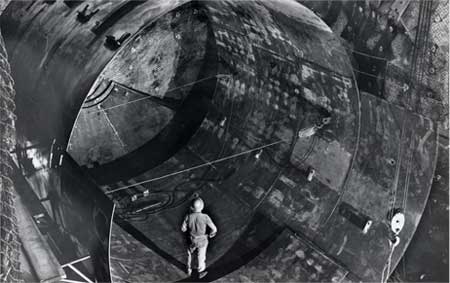 Dr. Ray Davis inspects his neutrino detector
under construction Dr. Ray Davis inspects his neutrino detector
under construction in the Homestake gold mine.
(1965) A laboratory 4,850 feet underground in the
Homestake gold mine in Lead, South Dakota, helped start a
revolution in physics. Dr. Ray Davis installed a
neutrino detector in Homestake in 1965. Neutrinos are
subatomic particles produced by fusion in stars, and over the
course of three decades, the Davis experiment led to the
discovery that the neutrinos produced in our sun change type,
or "flavor," on their way to earth. The change in flavor meant
neutrinos had to have at least a wisp of mass -- a wisp that
required a significant change in the Standard Model of how the
universe works. http://www.sanfordundergroundlaboratoryathomestake.org/index.php?option=com_content&view=article&id=140&Itemid=42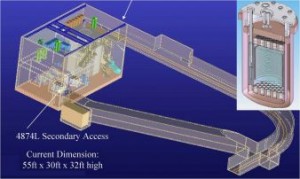 Depth is Homestake's crucial asset. A thick
layer of the earth's crust can stop most cosmic radiation.
Ultra-sensitive detectors in deep, quiet labs, where they are
protected from surface noise, can probe the universe's
best-kept secrets. Experiments planned for the new Homestake
lab include bigger, more sophisticated neutrino detectors.
Other detectors will look for even more elusive phenomena such
as dark matter, proton decay and neutrinoless double-beta
decay. ... Today the deepest, largest underground
laboratories are in Japan, Canada and Italy, but those labs
have waiting lists for experiments. A deep lab at
Homestake could more than double the world’s inventory of
underground lab space. http://www.ars.usda.gov/research/publications/publications.htm?seq_no_115=217575Title:
Industrially useful microorganisms isolated from deep
underground science and engineering laboratory (DUSEL) mine
biofilms Publication Date: November 4,
2007 ... The Deep Underground Science and Engineering
Laboratory (DUSEL) mine provides one of the most promising
sources for microorganisms to date. These microorganisms
have systematically evolved from organisms introduced from the
surface to deep below ground level by humans and animals
during mining and through water run off into the mine.
The microorganisms in this deep mine have been
subjected to temperatures in excess of 100ºC, little external
radiation, and in many cases have used lignocellulosic
material as a food substrate. The wood in these mines is
covered with biofilms that have evolved to survive the harsh
environment. It is the objective of this team at South Dakota
School of Mines and Technology (SDSM&T), South Dakota
State University, and United States Department of Agriculture,
National Center For Agricultural Utilization Research,
Agricultural Research Service to isolate and characterize
anaerobic and aerobic bacteria and fungi that are capable of
utilizing the lignocellulose at high temperature to produce
biofuels and valuable chemical feedstock for use in industrial
applications and to foster this new bioindustrial
infrastructure with profitable co-products for chemical
feedstocks, animal feed, and better production of starch and
cellulosic biofuels. The microorganisms will be
screened in high-throughput for growth on cellulose and
hemicellulose. They will be examined using automated
integrated robotic paradigms for combinations that give
optimum growth on recalcitrant lignocellulosic substrates and
for maximum ethanol production. ... New strains will
be engineered in high-throughput via mass transformation of
full length gene libraries to introduce these new DUSEL
gene sets into traditional ethanologenic microorganisms for
improved cellulases and hemicellulases as well as new genes
for metabolic corrections to allow utilization of pentose as
well as hexose sugars in fermentation processes. 
|
|
| | |
| TahoeBlue
|
http://permafrosttunnel.crrel.usace.army.mil/Take a Virtual Tunnel Tour. See
permafrost up close; learn about ice wedges, ice lenses, and
other permafrost features; see bones of the Pleistocene
bison, mammoth, and horse 25,000 year old Bacteria found in
Permafrost here have been revived Significant numbers of viable
ancient microorganisms are known to be present within the
permafrost. They have been isolated in both polar regions
from the cores up to 400 m deep and ground temperatures of
−27°C. The age of the cells corresponds to the longevity of
the permanently frozen state of the soils, with the oldest
cells dating back to ~3 million years in the Arctic, and ~5
million years in the Antarctic. They are the only life
forms known to have retained viability over geological time
Permafrost bacteria may slow down
ageing: scientists
January 17, 2012
Russian
scientists claimed that a hardy type of bacteria recently
discovered in the permafrost of Siberia could help slow down
the ageing process.
The species of bacteria -- given
the name Bacillius F -- was found in laboratory tests to have
shown signs of slowing down the process of ageing on mice, the
Russian Academy of Sciences (RAN) said.
The Siberian
branch of the RAN said Bacillius F lags 3 million years behind
similar bacteria in evolutionary terms, according to the
characteristics of proteins and some other factors.
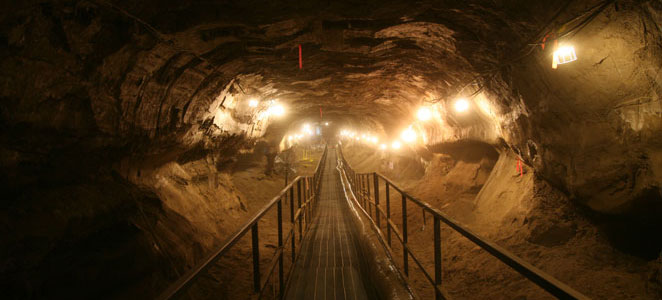 The United States Army The United States Army maintains and
operates a unique research facility near Fairbanks,
Alaska, known as the CRREL Permafrost Tunnel Research
Facility. CRREL is an acronym for the U.S. Army's Cold
Regions Research and Engineering Laboratory, part of the
U.S. Army Corps of Engineers Engineer Research and Development
Center. The Permafrost Tunnel was excavated from
1963–1969 for the study of permafrost, geology, ice science,
and the mining and construction techniques specific to
permafrost environments. The story of the tunnel
excavation is found in the Excavation Methods page of this Web
site. Fascinating features of the tunnel are described in the
Soil and Rock and Paleontology sections, and are shown during
the Virtual Tunnel Tour. The Permafrost Tunnel offers a
unique research platform for scientists and engineers who wish
to study a frozen environment over 40,000 years
old.Researchers at the CRREL Alaska Research
Office Fairbanks, Alaska, maintain and manage the Permafrost
Tunnel Research Facility and offer support for scientific
research projects. 
|
|
| | |
| TahoeBlue
|
Top 10 Fascinating Underground
LaboratoriesBuckle up as we go for a ride inside
the earth and take a look at what can be achieved when we look
down long enough for the Earth to get our attention and
whisper her secrets. 10 SNO and SNOLAB - Sudbury
Ontario Canada - Enter the Sudbury Neutrino
Observatory (SNO for short) is 2km (6,800 feet) deep in
the ground ( a mile plus 1514 feet) in Ontario,
Canada. 9 DUSEL - Lead South Dakota - The Deep
Underground Science and Engineering Laboratory (DUSEL) is a
futuristic underground project that is on the table and the
National Science Foundation is very excited by the prospect.
8 Aquarius Reef base - Florida Keys
Florida 7 Kola Super Deep Borehole Kola
Russia 6 Svalbard Seed Bank - Spitsbergan Island
Norway 5 Lake Vostok - Vostok Station
Antartica 4 Super Kamiokande - Hida Japan -
3,281 feet (1100m) below ground Laboratory. It is directly
under Mount Kamiokako, (kah-me-oh-cake-oh) near the Japanese
city of Hida 3 Gran Sasso - Gran Sasso Mountains
Italy - Gran Sasso National Laboratory has huge
underground facilities, so huge that they are in fact the
biggest underground laboratory in the World. 2
IceCube Nutrino Observatory - Antartica - The IceCube
project uses the natural ice of the South Pole instead of
water. A string of 70 (and later 86) holes are drilled into
the ice one and one half miles deep. 1 Cern -
Geneva Switzerland - CERN is the European Council for
Nuclear Research. (The letters make sense when said in French)
located 110 meters below ground in Northwest Geneva. They have
built a particle accelerator and have succeeded in crashing
two protons together at 99.99% of the speed of light. The CERN
organization is the largest gathering of scientists on the
planet incorporating the efforts of over 7,900 of them from
580 universities and over 80 nationalities. 
|
|
| | |
| TahoeBlue
|
http://www.jaea.go.jp/04/tono/miu_e/Tono
Geoscience Center (TGC), Japan Atomic Energy Agency (JAEA) has
been carrying out a wide range of geoscientific research in
order to build a firm scientific and technological basis for
geological disposal. One of the major components of
the ongoing geoscientific research program is th e Mizunami
Underground Research Laboratory (MIU) Project in the Tono
area, central Japan. Two 1,000m deep shafts and several
drifts will be excavated for geoscientific research and
applicability of engineering techniques will be
estimated. JAEA has been carrying out geoscientific
research at two locations: the location for
investigation of crystalline rock is in Mizunami City, Gifu
Prefecture; the location for investigation of
sedimentary rock is at Horonobe, Hokkaido. 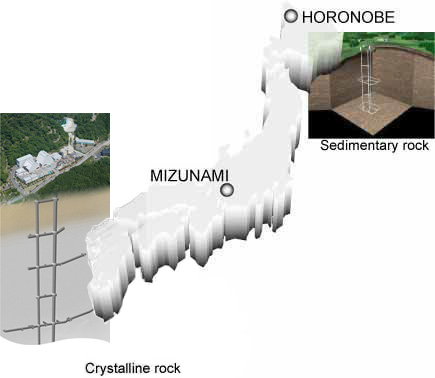 Master Plan of the Master Plan of the
Mizunami Underground
Research Laboratory Project 
|
|
| | |
| TahoeBlue
|
http://www.hep.shef.ac.uk/research/dm/boulby/boulby.phpBoulby
Underground Laboratory: the UK's deep underground
science facility, located 1100m below ground in Boulby
Mine on the North East coast of England. Boulby is the
home to the ZEPLIN-III and DRIFT-II Dark Matter search
projects and various other 'low background', geoscience
and environmental science studies. 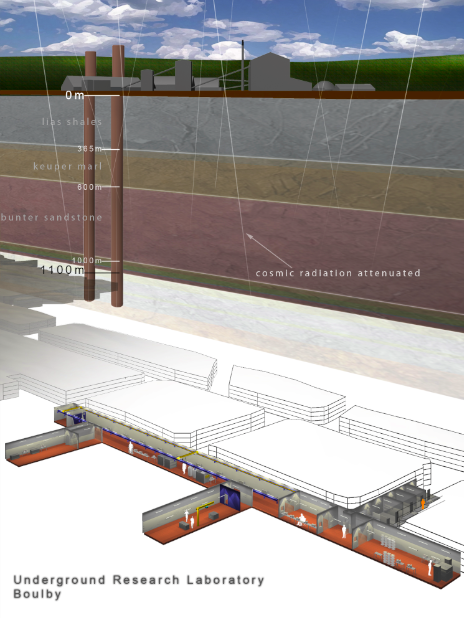 There is a huge network of roadways and
caverns underground at Boulby with over 1000kms of tunnel
having been excavated since beginning of mining operations in
1968. There is a huge network of roadways and
caverns underground at Boulby with over 1000kms of tunnel
having been excavated since beginning of mining operations in
1968. The salt and potash seams are left over from the
evaporation of an ancient sea (the Zechstein Sea) over 200m
years ago. The main roadways and long-lasting caverns are cut
into the rock-salt layer. Within the salt caverns UK
scientists and engineers have built a series of laboratories.
With over 1100m of rock overhead reducing cosmic rays by a
factor 1 million - and with the surrounding rock salt being
low in natural background radioactivity - the laboratories
make an ideal site for ultra-low background and deep
underground science projects. http://en.wikipedia.org/wiki/BoulbyBoulby
is a village in the borough of Redcar and Cleveland and the
ceremonial county of North Yorkshire, England. It is
located just off the A174 near Easington, and 1 mile west of
Staithes. ... To the north-west of the village is Boulby
Quarries a Site of Special Scientific Interest designated due
to its geological interest. Boulby is also home
to Cleveland Potash at Boulby mine - Europe's
second-deepest mine, where potash and rock salt is mined 2
kilometres (1.2 mi) underground. 
|
|
| | |
| TahoeBlue
|
In Europe, Finland is developing an
underground characterisation facility at Olkiluoto, known as
the ONKALO, which has now reached a depth of about 320m.
If ONKALO confirms that the site meets all the safety case
criteria for the development of a repository, a facility will
be developed at the site with a planned commencement of
disposal operations around 2020. http://www.posiva.fi/en/research_development/onkaloONKALO
One element of the site investigations conducted at
Olkiluoto is the excavation of the underground rock
characterisation facility (ONKALO) that will be extended to
the final disposal depth (approximately -400m). ONKALO
aids in collecting the further data needed for the application
for the construction licence that will be submitted in
2012. The bedrock is studied with methods from geology,
hydrology and geochemistry. In addition to facilitating
bedrock research, ONKALO also provides an opportunity to
develop excavation techniques and final disposal
techniques in realistic conditions. Later, the ONKALO
facilities can be put into use when building and using the
repository. Posiva started to construct ONKALO in
2004. Research has been conducted there since the
beginning of its construction. ONKALO consists of one
access tunnel and three shafts: a personnel shaft and two
ventilation shafts. The slope of the tunnel is 1:10. It is 5.5
m wide and 6.3 m high http://www.posiva.fi/en/research_development/onkalo/onkalo-animation/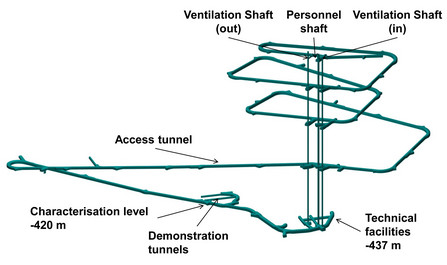 
|
|
| | |
| TahoeBlue
|
http://english.peopledaily.com.cn/90001/90776/90881/7229358.htmlChina's
1st deep underground lab now operational for dark
matter14:29, December 13,
2010China's first deep underground laboratory
was formally put into service in Jinpin hydropower station in
Sichuan Province on Dec. 12, which means China now
possesses an independent cutting-edge underground scientific
research and experimental platform in physics. Cheng
Jianping, director of the project, said the
lab is currently the deepest underground lab in the world with
vertical rock coverage of 2,400
meters.Experts from the project said the
deep underground laboratory is of great importance for
research of major leading basic research topics, including
dark matter, particle physics, nuclear physics, neutrino
physics, astrophysics and cosmology, and is a sound
environment for research of rock mechanics, earth structure,
ecology, low-level radioactive materials and nuclear radiation
detection for environmental protection. Experts from
the China Institute of Atomic Energy, Tsinghua University,
Sichuan University and the Ertan Hydropower Development
Company formed a cooperation group to conduct dark matter
detection experiments using a germanium detector made by
germanium crystal material with the highest purity in the
world. The lab’s first research on dark matter is expected to
be completed in 2011. http://asia.iop.org/cws/article/news/47110the
Jinping Underground Laboratory is situated some 2.4 km
underneath the Jinping Mountain in Sichuan
province. ... As the lab is underneath several
kilometres of marble and sandstone, spurious signals from
cosmic rays are blocked, making it an ideal surrounding in
which to search for dark matter – the mysterious
substance that accounts for about 80% of the matter in the
universe. The Jinping lab will initially house two experiments
in that quest. Already installed is the China Dark Matter
Experiment, which is a collaboration of about 30 physicists
led by Tsinghua University that will use a germanium detector.
http://wwwgerda.mppmu.mpg.de/symp/03_Yue.pdfChina
JinPing underground Laboratory (CJPL) and China Darkmatter
Experiment (CDEX) 
|
|
| | |
| TahoeBlue
|
http://www.globalsecurity.org/wmd/world/russia/yamantau.htmYamantau
Beloretsk-15 Beloretsk-16 Alkino-2 ? 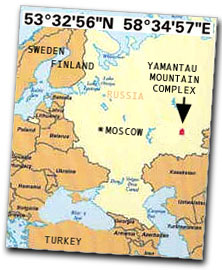 Starting in the Brezhnev period, Russia
has been pursuing construction of a massive underground
facility at Yamantau Mountain and the city of Mezhgorye Starting in the Brezhnev period, Russia
has been pursuing construction of a massive underground
facility at Yamantau Mountain and the city of Mezhgorye
(formerly the settlements of Beloretsk-15 and Beloretsk-16).
The complex, reportedly being built by tens of thousands of
workers, is said to cover an area of up to 400 square miles,
the size of the Washington area inside the
Beltway. The exact location of this large
facility is uncertain, and given its reported size it may
span as much as an entire degree of latitude and longitude. It
is apparently located near the the Zlatoust-36/Yuryuzan
nuclear weapons production plant and the Yuryuzan
national-level nuclear weapons storage facility. The Yaman-Tau
Gory [mountains] range is centered at 52�25'N 56�45'E, while
the peak of Yamantau Gora [mountain] is at 54�15'19"N
58�06'11"E. The town of Beloretsk is located at 53�58'N
58�24'E, though NIMA does not include a listing for Mezhgorye.
This facility may be synonymous with "Alkino-2" since the town
of Al'kino is nearby at 55�05'N
58�04'E. ... The New York Times quoted Russian
officials describing the underground compound variously as a
mining site, a repository for Russian treasures, a food
storage area, and a bunker for Russia's leaders in case of
nuclear war. "The (Russian) Defense Ministry declined to
say whether Parliament has been informed about the details of
the project, like its purpose and cost, saying only that it
receives necessary military information," according to the New
York Times. Satellite photographs of Yamantau
Mountain show continued digging at the "deep undergound
complex" and new construction at each of the site's
above-ground support areas. Judging from satellite photos
and other intelligence, US officials are fairly confident
that the Russians are building an underground command bunker
and communications installation. But "... the
Russians are not very interested in having us go in there," a
senior American official said in Washington. "It is being
built on a huge scale and involves a major investment of
resources. The investments are being made at a time when the
Russians are complaining they do not have the resources to do
things pertaining to arms control." http://www.bibliotecapleyades.net/sociopolitica/esp_sociopol_underground16.htmWhat's
Going On in The Yamantau Mountain
Complex?Today, Russia may be conducting nuclear
deception on a far vaster scale beneath Yamantau Mountain,
where it has dug out a gigantic underground military complex
designed to withstand a sustained nuclear assault. A U.S.
intelligence source was quoted as saying that the Yamantau
complex is but one of some 200 secret deep underground nuclear
war-fighting sites in Russia, many of which have been
significantly upgraded over the past six years at a cost of
billions of dollars. ... In 1998, in a rare
public comment, then-Commander of the U.S. Strategic Command
(STRATCOM) Gen. Eugene Habinger, called Yamantau "a
very large complex -- we estimate that it has millions of
square feet available for underground facilities. We don't
have a clue as to what they're doing there."It is
believed to be large enough to house 60,000 persons, with a
special air filtration system designed to withstand a nuclear,
chemical or biological attack. Enough food and water is
believed to be stored at the site to sustain the entire
underground population for months on end. "The only
potential use for this site is post-nuclear war..."
--- Rep. Roscoe Bartlett http://en.wikipedia.org/wiki/Mount_YamantauMount
Yamantau (Russian: гора Ямантау) is in the Ural Mountains,
Bashkortostan, Russia. The name means bad (evil) mountain in
the Bashkir language (Яман тау). It is also known as Mount
Yamantaw[citation needed]. It stands at 1,640 metres (5,381
ft) and is the highest mountain in the southern Urals. Along
with Kosvinsky Mountain (600 km to the north), it is suspected
by the United States of being a large secret nuclear facility
and/or bunker.[1] The closed military town of Mezhgorye
(Russian: Межгорье) is situated nearby. As late as 2003,
Yamantaw was not yet fully operational.[1] Large
excavation projects have been observed by U.S. satellite
imagery as recently as the late 1990s, during the time of
Boris Yeltsin's government after the fall of the Soviet
Union.[1] Two garrisons, Beloretsk-15 and Beloretsk-16, were
built on top of the facility, and possibly a third, Alkino-2,
as well, and became the closed town of Mezhgorye in 1995. They
are said to house 30,000 workers each. Repeated U.S. questions
have yielded several different responses from the Russian
government regarding Mount Yamantaw.[2] They have said it is a
mining site, a repository for Russian treasures, a food
storage area, and a bunker for leaders in case of nuclear
war ... Russian newspapers reported in 1996 that it
is a part of the "Dead Hand" nuclear retaliatory command
structure. 
|
|
| | |
| TahoeBlue
|
http://www.deepscience.org/contents/facilities.shtml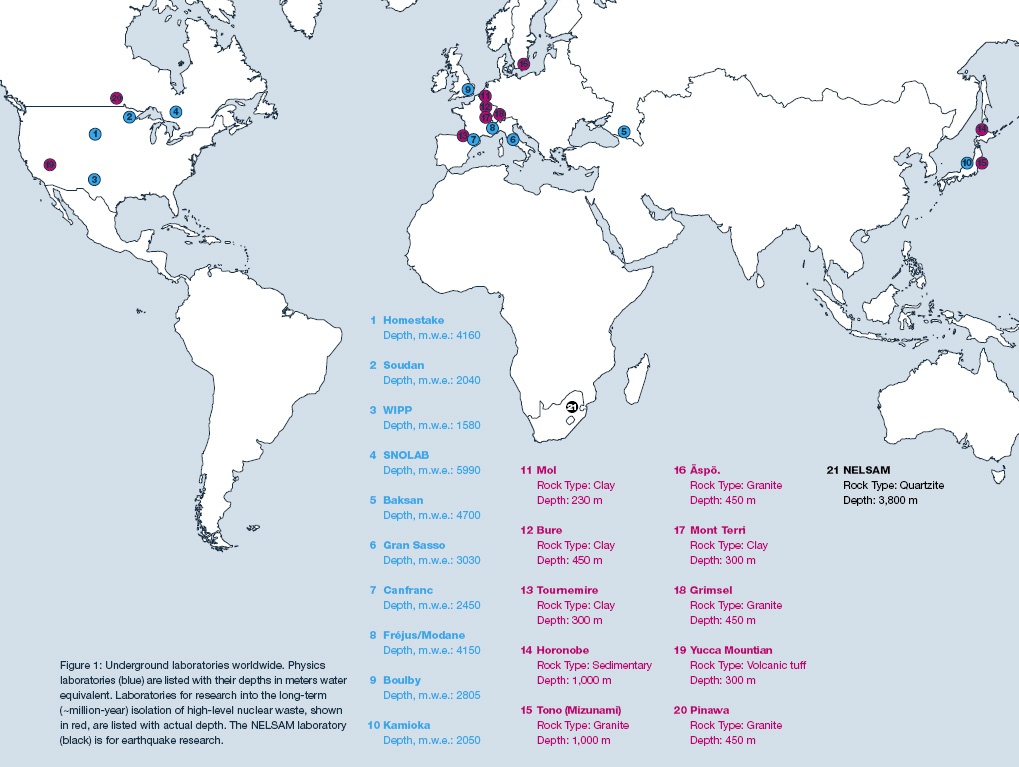 Facilities for Deep
Science Facilities for Deep
ScienceThe 21st century exerts increasing demands
to go underground. Expanding and developing populations put
growing pressure on surface space, driving mass transit
systems, hydroelectric plants, energy storage, waste disposal
facilities and a host of other systems underground. The
depletion of shallow mineral and energy resources sends
prospectors ever deeper in search of essential raw materials
and new sources of energy. Yet despite the demand for
subsurface space and resources, major engineering obstacles to
underground use remain. 
|
|
| | |
|
|
| TahoeBlue
|
http://www.globalsecurity.org/military/facility/range-navy.htm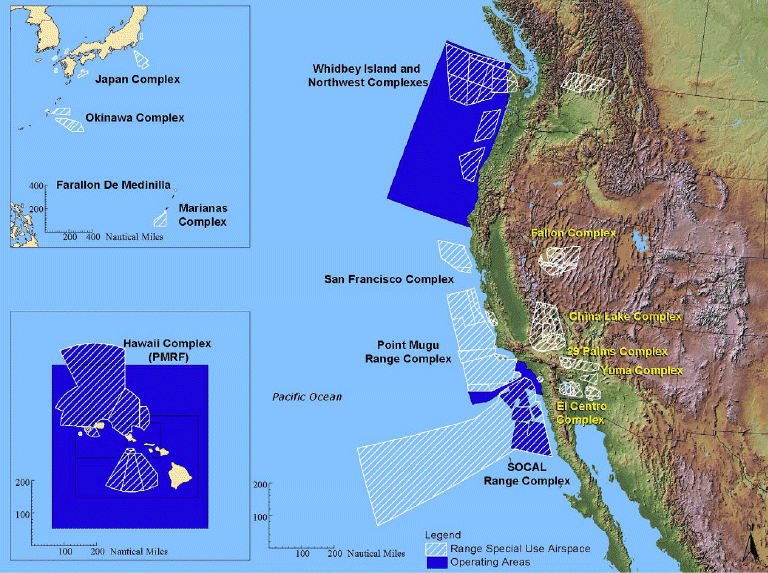 http://www.globalsecurity.org/military/facility/socal.htmSouthern
California (SOCAL) Offshore Complex http://www.globalsecurity.org/military/facility/socal.htmSouthern
California (SOCAL) Offshore Complex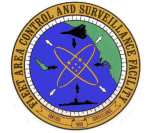 The SOCAL Offshore Complex also includes
W-291 and Marine Corps Base (MCB) Camp Pendleton. The
complex is located along the coast and in the waters adjacent
to Southern California from Santa Barbara to Baja
California. The complex is composed of the
following instrumented areas: ■Fleet Training Area (FLETA)
■San Clemente Island Underwater Range/Operating Area
(SCIUR/OPAREA) 3803 ■Shore Bombardment Area (SHOBA)
■SOCAL ASW Range (SOAR) ■Range Electronic Warfare
Simulator (REWS) ■Large Area Tracking Range (LATR)
■Camp Pendleton Amphibious Assault
Operations/Artillery/Aircraft Bombing and ■Strafing Range
(R-2503) ■Shipboard Electronic Systems Evaluation Facility
(SESEF) http://www.scisland.org/aboutsci/score-development-history.pdfSouthern
California Offshore Range (SCORE)Development History
(1981-2007) The San Clemente Island Range Complex
(SCIRC) is the cornerstone of the tactical training ranges for
the Southern California Operations Area (SOCAL).
SOCAL supports the largest concentration of naval
forces in the world. The SCIRC land, air, and sea ranges
provide the U.S. Navy, U.S. Marine Corps, and other military
services, space and facilities which they use to conduct
readiness training, and test and evaluation
activities. ... THE SCORE MISSION The mission
of SCORE is to improve the combat readiness of Pacific Fleet
air, surface, and submarine units in all warfare areas
providing instrumented operating areas and associated
facilities to support training exercises. Ancillary
missions include support for evaluations of equipment and/or
tactical concepts developed to support Navy programs. Since
its inception in 1985, the use of SCORE can be directly
related to the U.S. Navy’s success in world conflicts, and the
high state of readiness that the Department of Defense enjoys
today. 
|
|
| | |
| TahoeBlue
|
The Moles Association is the most important
association of decision-makers and representatives of the US
heavy construction industry on the country’s east coast. The
former US President Herbert C. Hoover is also among those
who have been honored with the Moles Award in the
past http://themoles.info/organization/They
have been called “crazy men in a crazy industry” who gamble
their fortunes and reputations against the challenges they
meet. Often working underground, they change the face of
the earth, building tunnels, dams, highways and bridges. They
are defined as heavy construction workers. In
October 1936, a small group of these men who had worked
together between 1914 and 1919 on projects under Newark Bay
and on the waterfront of Port Newark had a reunion in Jersey
City. They had such a wonderful time reminiscing about
their experiences and discussing their work that they were
inspired to form a permanent organization. On that autumn
evening, what was to become the most prestigious heavy
construction organization in the world was
born. ... In 1950, the non member was former
president Herbert Hoover, who was labeled the "Grand Old
Mole" for his engineering expertise. At the same dinner,
Dwight D. Eisenhower was the Principal Speaker and was
presented with Honorary Membership. Recognizing the rising
prominence of women in the heavy construction industry, the
Moles initiated its first female member in 1992. The
tradition of presenting two awards each year to outstanding
construction individuals has continued to this day at the
Annual Awards Dinner held each year in New York City on the
last Wednesday of January. The giants of the U.S.
construction industry have been and continue to be
honored. Such individuals as Stephen Bechtel, Harry
W. Morrison, Peter Kiewit, Lou Perini and Guy F.
Atkinson were among the earlier recipients. In 2011,
Robert E. Alger of The Lane Construction Corporation and Peter
O. Shea of J.F. Shea Co., Inc. were the
honorees. The tradition of having a Principal
Speaker has also continued. The Honorable Michael R.
Bloomberg, Mayor of New York City was the 2011 Speaker.
Earlier speakers included Richard M. Nixon, House
Speaker Thomas P. (Tip) O'Neill, New York City Mayor Edward
Koch and New York State Governor Mario M. Cuomo. 
|
|
| | |
|
|
| TahoeBlue
|
They are either preparing for WW3 or
Nibiru's passing ? 
It's
obvious to me that these TBM manufacturers have been boring
underground privately for governments for years and now they
are more public commercially. Also notice that these
machines are dependent on Tungsten and the company that
dominates Tungsten is owned by the Israelis and Warren
Buffet.Another good article: http://pediaview.com/openpedia/Tunnel_boring_machine... The
largest diameter TBM, at 19.25 m, built by Herrenknecht AG for
a recent project in Orlovski Tunnel, St.Petersburg. The
machine was built to bore through soft ground including sand
and clay. The largest diameter hard rock TBM, at 14.4 m, was
manufactured by The Robbins Company for Canada's Niagara
Tunnel Project. The machine was used to bore a hydroelectric
tunnel beneath Niagara Falls, the machine has been named "Big
Becky" in reference to the Sir Adam Beck hydroelectric dams to
which it is tunnelling to provide an additional hydroelectric
tunnel. Tungsten:
http://www.todaysmachiningworld.com/an-interview-with-eitan-wertheimer-2/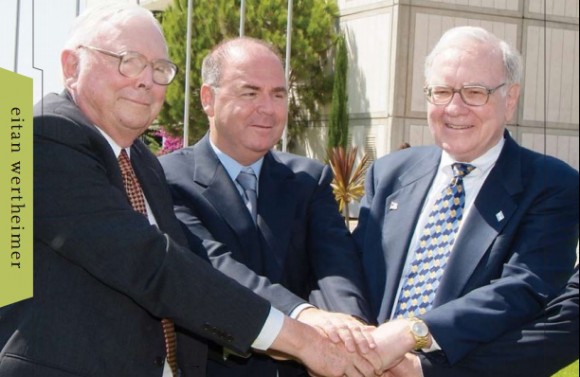 Berkshire Hathaway's Charles
Munger, Eitan Wertheimer, Warren Buffet, Stef
Wertheimer [ out of picture ] ... Lloyd: Israel
Carbide, ISCAR; the company has been synonymous with Israel
for its whole history. You were born four years after
Israel was born. The company grew parallel to the state. What
does selling out to Warren Buffet in 2006 mean in terms of
Israel, or was it purely a business decision on your
part? Eitan: It wasn’t selling out. It was a basic idea of
becoming part of something bigger, and happily that
opportunity opened up. We wanted to secure our customers and
our people for yet again another 50 years or
more. 2006:http://www.forbes.com/lists/2006/10/YDQK.html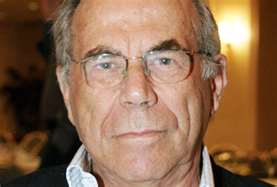 Billlionaire #317 Stef Wertheimer &
familyFounded Iscar, one of the world's largest
(by sales) manufacturers of carbide industrial-cutting
tools Billlionaire #317 Stef Wertheimer &
familyFounded Iscar, one of the world's largest
(by sales) manufacturers of carbide industrial-cutting
tools, which are used by carmakers like GM and Ford. Son
Eitan, who along with his wife owns Israel's largest
horse-breeding stud farm, is Iscar's president. Stef
Wertheimer also seeds high-tech Israeli startups through four
industrial parks In 2002 he testified before Congress
about his idea for a "new Marshall Plan" that advocates
U.S. funding to revitalize the Middle East, a plan he
still champions in speeches across the
world. 2008:http://www.forbes.com/lists/2008/10/billionaires08_Stef-Wertheimer-family_YDQK.htmlBillioinaire
#222 Stef Wertheimer & family -
03.05.08 From one billionaire to another. In May
2006 Warren Buffett's Berkshire Hathaway paid $4 billion for
80% of Iscar, the manufacturer of precision carbide
metalworking tools founded by Stef Wertheimer in 1952. His
son Eitan has continued to run the company with Buffett's
support. Stef lobbies on behalf of his "Marshall Plan for
the Middle East," based on the idea that industrial parks like
one he has in the Galilee can bring peaceful coexistence by
having Jews and Arabs work together. Also invested in a
handful of other Israeli businesses, including Blades
Technology, a maker of jet-engine blades. Berkshire
Hathaway's Charles Munger,[ http://www.charlesmunger.com/Charles
Thomas Munger is often considered Warren Buffet's partner
since he is the Vice-Chairman of Berkshire Hathaway
Corporation, but he was an investor in his own right before
joining Berkshire. ... Charles T. Munger’s political
views are different from Warren Buffet’s too. Buffet leans
towards the left and contributed money to Barack Obamba’s
campaign. Munger is a Republican http://en.wikipedia.org/wiki/Charlie_MungerMunger
is also the chairman of Wesco Financial Corporation, based in
Pasadena, California ... now controls Precision Steel Corp.,
CORT Furniture Leasing, Kansas Bankers Surety Company, and
other ventures. Wesco Financial has an equity portfolio of
over $1.5 billion dollars that is concentrated in Coca-Cola,
Wells Fargo, Procter & Gamble, Kraft Foods, US Bancorp,
and Goldman Sachs.
WWIII - Tungsten Carbide is used
for war materials....http://www.koreatimes.co.kr/www/news/biz/2007/10/123_12548.html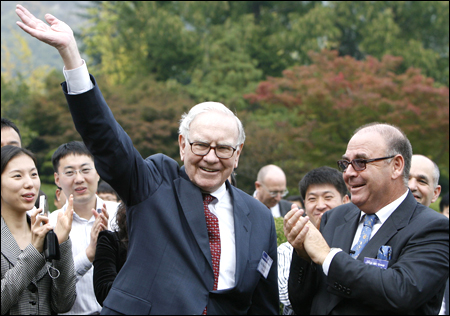 http://www.daylife.com/photo/0bxLeZfdtKd8c http://www.daylife.com/photo/0bxLeZfdtKd8c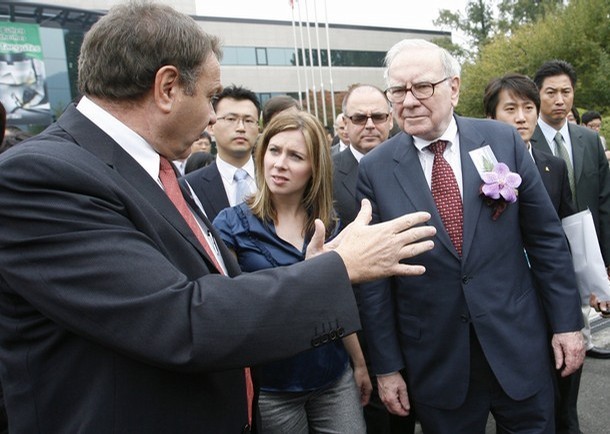 Berkshire Hathaway Inc's Warren Buffett (R)
visits a factory of TaeguTec in Daegu, about 300 km (189
miles) southeast of Seoul October 25, 2007. Buffett
visited South Korea for the first time on Thursday to
tour unlisted TaeguTec. http://www.bloomberg.com/news/2011-03-20/buffett-s-japanese-toolmaker-evacuates-staff-in-fukushima.htmlBuffett’s
Japanese Toolmaker Evacuates Staff in Fukushima After
Earthquake By Jun Yang - Mar 20,
2011Warren Buffett’s tool-making unit Iscar
Metalworking Cos. said sales may decline in Japan after
the company evacuated most of the 1,400 employees from its
local headquarters as radiation leaks from a nuclear plant.
... Wertheimer and Buffett canceled a visit to
the Tungaloy operations, where buildings and machinery
were damaged in the magnitude-9 temblor, and extended their
stay in South Korea until March 22. ... Buffett,
80, will travel to Seoul later today to meet South Korean
President Lee Myung Bak after a ground-breaking
ceremony for a new TaeguTec factory in Daegu. He
will fly to India on March 22, said Wertheimer, who
describes himself as Buffett’s “travel agent.” http://en.wikipedia.org/wiki/TaeguTecTaeguTec
Ltd. (Korean: 대구텍), formerly known as Korea Tungsten Co. (KTC,
대한중석), is a multi-national corporation headquartered in Daegu,
Korea. It is Korea’s largest manufacturer of
tungsten cutting tools and hard metal tools with the only
integrated tungsten production plant in the
world... In May 2006, Berkshire Hathaway,
chaired by Warren Buffett, purchased an 80% stake in
TaeguTec’s holding company, the IMC Group of Israel, for US$5
billionhttp://www.bloomberg.com/news/2011-03-20/buffett-s-japanese-toolmaker-evacuates-staff-in-fukushima.htmlBuffett’s
Japanese Toolmaker Evacuates Staff in Fukushima After
EarthquakeBy Jun Yang - Mar 20, 2011
... Buffett, ranked the world's third-richest man by
the Forbes 2011 list, is scheduled to attend a
ground-breaking ceremony in South Korea on March 21,
and will speak at a new factory opening in Japan on March
22. http://www.businessweek.com/smallbiz/content/mar2008/sb20080314_011498.htmWho
Is Stef Wertheimer? March 14, 2008 The Israeli
industrialist has a unique perspective on how to reduce
conflict in the Middle East Early on, Stef Wertheimer,
the founder of Iscar Metalworking, a manufacturer of
industrial precision metal-cutting tools, ... In
May, 2006, Wertheimer and Iscar made global headlines when
Berkshire Hathaway's (BRK) Warren Buffett announced he had
acquired an 80% stake in Iscar for $4 billion (see
BusinessWeek.com, 05/08/06). When Buffett traveled to the
country to visit his new investment (see BusinessWeek.com,
09/18/06) four months later he told the Israeli press:
" Iscar and the Tefen Industrial Park should be taken as an
example…around the world of what can be done against all
odds." ... Investing in a VisionSays
David Rubin, the former Israeli Economic Minister to
North America and currently a consultant to Israeli
high tech companies: "[Stef]'s industrial parks are
probably the largest private contribution to Israeli
entrepreneurship ever http://www.imd.org/about/pressroom/pressreleases/Warren-Buffett-and-Eitan-Wertheimer-celebrate-20-years-of-family-business-research-and-education-at-IMD.cfmMay
20, 2008 - Lausanne, Switzerland Text Warren
Buffett, CEO of Berkshire Hathaway Inc., and Eitan Wertheimer,
Chairman of the Board of Iscar, took part in a full day
of activities on IMD’s campus in Lausanne, Switzerland to
celebrate 20 years of family business research and
education at IMD. ... About Iscar Iscar is a
producer of unique and innovative cutting tools for
metalworking, including turning, grooving, milling, hole
making, boring and threading tools. In the past 56 years it
has expanded from a single marketing and manufacturing
facility in Israel to a multinational company with
representation in over 50 countries. 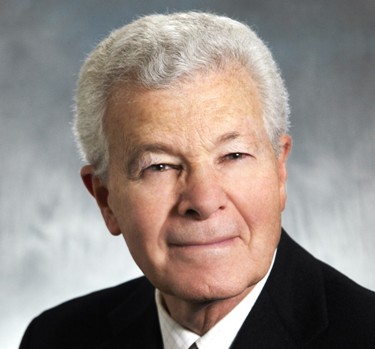 http://www.shalomlife.com/eng/14802/Business_Opportunities_Lie_in_the_Areas_of_Specialty/ http://www.shalomlife.com/eng/14802/Business_Opportunities_Lie_in_the_Areas_of_Specialty/"Business
Opportunities Lie in the Areas of Specialty" http://investing.businessweek.com/businessweek/research/stocks/private/person.asp?personId=934608&privcapId=5434958&previousCapId=1670586&previousTitle=FORMULA%20VISION%20TECHNOLOGIESDavid
J. Rubin Return to FORMULA VISION
TECHNOLOGIES Chairman, President, and Chief Executive
Officer, TIX Group BACKGROUND Mr. David J. Rubin is
the founder, Chairman, and Chief Executive Officer of Tech
Capital Ltd., a company devoted to developing and supporting
Israel - US investment activities. He is also
Chairman, President and Chief Executive Officer at TIX Group.
From October 1998 through August 1999, Mr. Rubin was the
President and Chief Executive Officer of Aura Investments
Ltd., an investment company focusing on high-tech start-ups
which is traded on the Tel Aviv Stock Exchange ... (TASE).
Mr. Rubin was the Israeli Economic Minister to North
America, operating out of New York and heading the Government
of Israel's nine economic offices in the U.S.A. and
Canada. Former Director Israel Military Industries
Ltd.OTHER AFFILIATIONS Matrix IT
Ltd. Aura Investments Ltd., Prior to Change in Line of
Business Dan Hotels Corp. Ltd. Tech Capital
Ltd. Formula Vision Technologies (F.V.T) Ltd. Formula
Telecom Solutions Ltd. Walla! Communication
Ltd. Israel Military Industries Ltd.Sintec
Advanced Technologies Ltd. Polytechnic Institute of New
York University Sun D'or International Airlines Israel
Foreign Trade Risks Insurance Corporation Ltd., The Elul
Technologies Ltd. BSR Europe Ltd. MIT Sloan School of
Management [ Sloan = Rockefeller ]
example:
William F. Pounds Professor Emeritus of Management;
Dean Emeritus, MIT Sloan - From 1981 to 1991,
he was the senior adviser to The Rockefeller
Familyhttp://www.jewishtribune.ca/TribuneV2/index.php/20080709750/Israel-s-pioneering-spirit-alive-and-well-Israeli-chamber-tells-Canadian-business.html... Most
famously, Israel achieved a coup in 2006 when noted
billionaire investor Warren Buffett jumped on the bandwagon.
“Israel has amazing people. We are investing
$4 billion in an amazing group of people from Israel – and we
are investing it at an astounding speed,” he said at the
time.. .... The purchase of an 80 per cent stake in Iscar
Metalworking Cos. is the largest investment that
Buffett has ever made outside the US. ... Israel
is the second-largest participant on the NASDAQ stock market
after the US. “And this is not per capita,” he hastened to
add. ... The CICC relaunched in May 2006 after a
seven-year hiatus. Currently seeking to grow its membership,
its goal, according to the organization’s president, David
Rubin of Gowlings law firm, is “to promote beneficial
opportunities between Canada and Israel.” http://www.2space.net/news/article/344262-1300678804/Warren
Buffett (C) poses with employees of TaeguTec in Daegu,
...  Mar 21st, 2011 (Reuters) - Warren Buffett
(C) poses with employees of TaeguTec in Daegu, about 300 km
(189 miles) southeast of Seoul, March 21, 2011. The world’s
third-richest man who is worth $50 billion, according to the
Forbes’ 2011 ranking http://www.2space.net/news/article/344266-1300680603/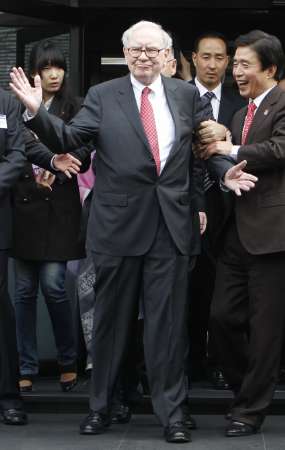 Mar 21st, 2011 Mar 21st, 2011(Reuters) -
Warren Buffett (C) gestures after missing his footing
on the stairs as he visits a factory of TaeguTec before
attending a ground-breaking ceremony for the factory, run
by a unit of an Israeli firm owned by his Berkshire Hathaway
Inc, in Daegu, about 300 km (189 miles) southeast of
Seoul, March 21, 2011. 
|
|
| | |
| Constitutionary
|
I hear them keep bringing
it up on Coast-to-Coast AM but I wish there were some
astronomers with some credible proof.
Last I heard they
have an observatory in Antarctica monitoring Nibiru's
apporoach but nothing saying that it'll pass with no harm,
some gravitational sheering on the Earth or complete upheaval
of life on Earth as we know it.
Just think how fast the
manufacturing jobs would return if Nibiru did devastate the
Earth ? 
|
|
| | |
| TahoeBlue
|
http://www.china-daily.org/Mil-News/India-Pakistan-nuclear-strike-against-hundreds-of-large-nuclear-bunker-planned/India
Pakistan nuclear strike against hundreds of large nuclear
bunker planned 2010-12-07 LONDON December 7
news : According to "Pakistan Observer" reported on
December 5, from Pakistan in response to the potential threat
of war with China, India has begun the construction of large
urban centers and military nuclear bunker. Under this
military plan, India will build hundreds of underground large
nuclear bunker, Pakistan and China to prevent the possible
implementation of the "nuclear strike." It is
reported that India's nuclear bunker in the capital, Mumbai,
Chennai, the fourth largest city, as well as the
implementation of Kolkata city built along the subway lines.
Some large bunker can accommodate a variety of essential
facilities, including command and control centers, hospitals
and training centers. In the event of war, each
of a large bunker can accommodate up to 8,000 individuals;
special shelter will be designed to suffer a nuclear attack,
including the President and the Prime Minister specifically
for the Indian government at all levels, including executives
are using. recently, popular among the Indian
army, a new war doctrine, may also face competition from India
said Pakistan and China, two-sided fight; while India has also
been working to enhance its military capabilities. India's
domestic nuclear-powered submarine "destroy the enemy who" was
the beginning of deterrence will cruise in 2 years to complete
the Indian land-based, space-based and strategic weapons
delivery underwater Trinity System. Wilma said the Indian
Navy chief Admiral, with land-based, space-based and
underwater delivery of strategic nuclear missiles, India
really has a trinity of nuclear power. He said: "We
specifically undertake not to use nuclear weapons first, but
we have a 'destroy the enemy who' number; that the trinity of
our system has been established, we must use it as efficiently
as possible 
|
|
| | |
| TahoeBlue
|
http://www.pakalertpress.com/2011/06/23/israels-leaders-hole-up-in-nuclear-bunker/Israel’s
leaders hole up in nuclear bunkerPosted on Pakalert on
June 23, 2011 Israeli leaders holed up in a new
underground nuclear bunker on Wednesday as part of annual
nationwide maneuvers to prepare for a possible missile war
with Iran, Syria and their Lebanese and Palestinian guerrilla
allies. Officials said it was the first time
that the security cabinet, headed by Prime Minister Benjamin
Netanyahu, had tested the bunker, dug deep in the western
Jerusalem foothills over the past decade and dubbed
the “Nation’s Tunnel” by local
media. Israel has held increasingly sweeping
civil defense drills since the 2006 Lebanon war, during
which Hezbollah guerrillas fired thousands of short-range
rockets at its northern towns. 
|
|
| | |
| TahoeBlue
|
http://mystic-places.blogspot.com/2008/07/kelvedon-hatch-secret-nuclear-bunker.htmlMonday,
July 21, 2008 Kelvedon Hatch Secret Nuclear Bunker
Posted by Rochak at 2:26 AM Inside a rural
bungalow nestling in the Essex countryside lies the twilight
world of the Government Cold War. Behind the blast screens
that protect this bungalow is the entrance to an amazing
labyrinth of rooms built into a hillside, encased in 10
feet thick reinforced concrete 75 feet
underground. The Secret Nuclear Bunker at
Kelvedon Hatch, in Essex, England, is a large underground
bunker used during the cold war as a Regional Government
Headquarters. Since being decommissioned in 1992, the
bunker has been open to the public as a tourist attraction
(known as the Secret Nuclear Bunker), with a museum
focusing on its cold war history. 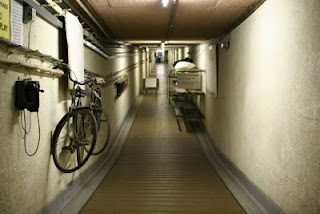 
|
|
| | |
| TahoeBlue
|
http://lens.blogs.nytimes.com/2011/07/11/inside-titos-nuclear-bunker/July
11, 2011, 5:00 am Inside Tito’s Nuclear Bunker
By THE NEW YORK TIMES During the convulsions that
upended Yugoslavia in the 1990s, a secret came to light near
the Bosnian town of Konjic. There — it turned out — the
dictator Josip Broz Tito had constructed a labyrinthine
bunker complex 900 feet below ground to protect him and
his inner circle in the event of a nuclear attack. Today, it
seems as remote as Yugoslavia itself. 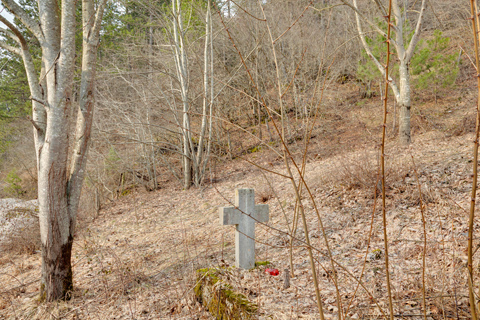 A camouflaged entrance to the bunker,
outside the town of Konjic A camouflaged entrance to the bunker,
outside the town of Konjic 
|
|
| | |
| TahoeBlue
|
The only reason they would give these
bunkers away is if they have something new and
better...http://society.ezinemark.com/cold-war-nuclear-bunker-for-sale-in-scotland-7d2d4b9e37fb.htmlCold
War nuclear bunker for sale in Scotland A Cold
War nuclear bunker in Scotland has been put on the property
market by its owners, Comrie Development Trust
(CDT). The nuclear bunker is located beneath
the rolling Scottish hills of the former Cultybraggan Camp,
over a mile south of the town of Comrie and within fifty
miles of Edinburgh and Glasgow. The former
military installation was built in 1939 and played host to
some of the most notorious Nazi prisoners of war during the
Second World War. Originally commissioned by the
Scottish Parliament, the huge underground bunker housed
over one hundred and fifty staff who worked to protect England
and Scotland from nuclear, biological and electromagnetic
attacks. It was the most technologically
advanced bunker built during the Cold War, complete with a BBC
studio, a canteen, a telephone exchange and
dormitories. Construction cost in the region of
US$48.2 million, which would be around US$144.4 million in
today’s money, allowing for inflation. ... 
|
|
| | |
| TahoeBlue
|
http://www.infiniteunknown.net/2010/11/05/swiss-nuclear-bunker-houses-worlds-toughest-server-farm/Swiss
Nuclear Bunker Houses World’s Toughest Server Farm
By Ian
Daly 05 October 2010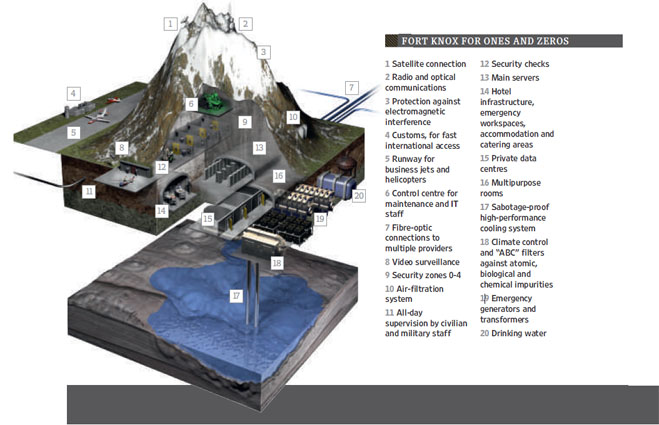 Deep inside the Swiss Alps, a former
nuclear bunker is now the ultimate hiding place for the
world’s most sensitive secrets. Wired gains access to the
server farm designed to survive a full-scale military
attack. Deep inside the Swiss Alps, a former
nuclear bunker is now the ultimate hiding place for the
world’s most sensitive secrets. Wired gains access to the
server farm designed to survive a full-scale military
attack.... “Sixteen years ago, nobody took us
seriously,” Oschwald says. “They said to us, ‘Storing data
under a mountain? Why?’” In the cheerier geopolitical climate
of the 90s, it was decidedly easier to scoff at the eccentric
Swiss entrepreneur, with his slicked-back hair and blinding
white smile, as he extolled the data-security benefits of his
decommissioned bunker. But today — with terrorism,
environmental disasters and financial meltdown on the global
agenda — some of the biggest players in technology and finance
are buying into the facility’s promise. Oschwald can tick
off blue-chip companies such as Cisco Systems, Novartis, UBS
and Deutsche Bank among his clients. The guards
stroll over to greet their boss, who is 6’ 2’’ and wears a
black raincoat and a dark-blue Italian suit. As he prepares to
escort Wired inside, he explains how nearly two decades of
work and an investment of more than 40 million Swiss francs
(£25 million) transformed a decaying bunker into a fortified
data repository. Swiss Fort Knox has a laundry list of
features straight out of a film script. There are five
security zones, a dedicated power supply, a cooling system
that pumps glacier water from an underground lake,
military-grade air filters that siphon atomic, biological and
chemical impurities from the air, an emergency hotel, several
months’ food, a conference room, and security, including
face-recognition surveillance software, bulletproof plastics
and vault doors courtesy of the Swiss banking industry. It is
also, thanks to its original use, designed to be impervious to
nuclear attack. “We had a four-star US general
who was partly responsible for the atomic-weapons programme
come here,” Oschwald says as the guards look on, “and he
said, ‘In America, we have a lot of space and a lot of
soldiers. But I have visited a lot of sites and this is
something… very special.’” As Oschwald speaks, a Subaru pulls
up and a stocky man in sunglasses exits the car carrying a
light-blue lockbox. He says a few words to one of the guards,
hands over the goods and speeds away. Oschwald seems unfazed
by the spectacle. He’s accustomed to nervy clients who still
prefer physical data transfer to the virtual. 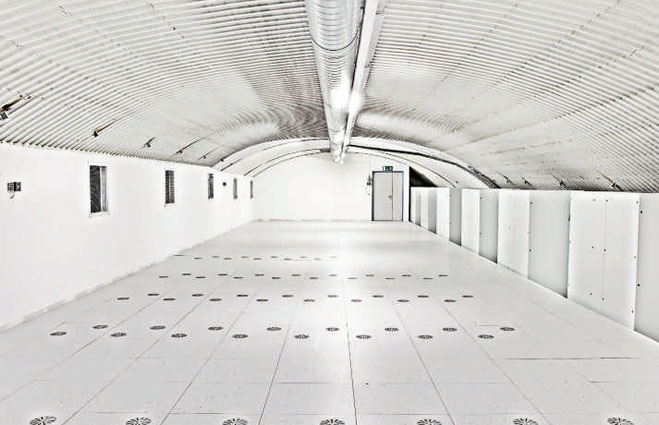 
|
|
| | |
|

.gif)


.gif)

